#the antagonists and the protagonist are all on the same path of destiny
Text

The 3 way stand-off these characters have with their ideologies is so fucking wild
#hmmmm 'we both fight for what we think is right' THEY SURE DO#the antagonists and the protagonist are all on the same path of destiny#it fucking rules#lmk#lego monkie kid#monkie kid#lmk mk#lmk azure lion#lmk lbd#lmk lady bone demon#lmk meme#when all the paths lead to pain rip
280 notes
·
View notes
Text
Anyway this isn't like an Official Literary Thing but I've talked with my old English profs about it / have been using it for fanon ATLA meta since like 2018 and thus thought it might be useful for others for meta / conceptualization purposes
Going to be using both ATLA and TDP as examples to help out, but let's dig into the concept of
primary, secondary, & tertiary foils
For example, the primary foils in both ATLA and TDP are Zuko-Aang and Viren-Callum, respectively. This is backed up by framing, plot arcs, what episodes and sometimes entire seasons are built around, etc. Zuko and Aang are both visually marked (scar, arrow) boys living in exile and unable to return home / to what they once knew, they are the main way the series explores concepts of destiny ("is it your own destiny or is it a destiny someone else has tried to force on you?" applies to Zuko as Aang's enemy and to Aang as a violent Avatar) and a plethora of other things, interacting in approximately 13/61 episodes in the series but having their bond/dynamic reinforced in many other episodes than that ("Bitter Work" and "The Storm" in particular).
Viren and Callum are very similar, being another antagonist-turned atonement arc and protagonist pair. S2 follows them operating in parallel (2x01 shutting a door in their face with magic/politics, engaging in dangerous behaviour in pursuit of magic but backing off in 2x04, reneging that choice and following through in 2x07, being faced with mirrors in 2x08, and getting magical upgrades in 2x09, even if Viren does so by embracing dark magic/Aaravos and being subsequently chained down, further while Callum has rejected it and unlocks the Sky arcanum, being subsequently freed). Season four and season five have merely cranked it up further by framing/paralleling S4 and S5 Callum further to Arc 1 Viren in framing, fears, and choices, as well as framing him in opposition to S4 and S5 Viren, allowing them to switch places, as Viren swears off all dark magic just as Callum opens that door back open within an episode of each other in S5.
However, these are hardly each other's only foil relationships, even if they are the most prevalent. This is where secondary and tertiary foils can come in handy.
For example, Soren has parallels to both Callum and Rayla. In arc 1, he and Rayla switch roles from a sworn protector turned killer turned back again, and a sworn killer sworn fervent protector, respectively. Soren and Callum are both greatly depleted in 2x07 thanks to following Viren's path (for Soren, it's escalating violence in a situation he can't win, and for Callum, it's dark magic) causing them to have big moments of reflection in 2x08. They are also both the older brothers who escape their fathers' mantles of dark mage and king, leaving those burdens uniquely on their younger siblings' shoulders of Claudia and Ezran. And Ezran is a parallel to Rayla of someone who is good hearted enough it gets them into trouble as well as their duties/devotion to world ("I have to go back home" + "I have to go after him" / "I feel like I'm letting everyone down" "I failed them, I let them all down" / "It's not fair you have to go through this alone" "I knew I had to be strong alone"). And of course, Callum and Rayla are big foils for each other as well, switching largely in the same manner that Viren and Callum do.
This is similar to how Aang also parallels Katara (cultural endurance, anger, and mercy) and Azula (elevated prodigy who creates resentment, freed and defeated by Katara from an icy confine) in ATLA, Toph parallels both Mai and Yue (who likewise parallel each other, all rich girls forced into a manner of repression due to their status and families, with various stages of breaking free & self sacrifice), and how Zuko parallels Katara (compassionate, sometimes hot headed, had to struggle more for their bending abilities) and Sokka (older brother to more 'talented' younger sister, missing mother and wanting to prove themselves to their fathers).
Typically when looking at plot and character arcs, primary foils are better indicators of how a character may swap with another or where they may end up, for ex: Azula and Katara are primary foils and this sets up both the Book 2 and Book 3 finales. In Book 2, Zuko chooses/helps Azula defeat Katara (and Aang), and Azula kills Aang; Katara, as her foil, is the one who saves him. Then, in Book 3, Zuko chooses/helps Katara defeat Azula, and then is also saved by her. Tertiary and secondary foils tend to be more complementary / help buff up theme for shorter episode arcs than series spanning stuff.
We see this again in S3 and S5 Callum and Viren, where S3 ends with Viren at his literal lowest and Callum at his literal highest, whereas in S5, they have the aforementioned dark magic trade off. You can also see this in smaller ways with characters like Rayla and Claudia (who I'd probably say are secondary for each other, but you really could make an argument for primary) switch in 4x09 and 5x09, with Claudia restoring Rayla's family to her whereas Rayla's defeat of Claudia is, in the mage's mind, why she ultimately loses her father / Claudia prioritizing her family over everything, whereas Rayla puts in the world first in S5.
Anyway it's fun and useful - who do you think certain characters primary, secondary, or tertiary foils are? Why would you categorize each one in each way, are there multiple of each? Etc, etc. It can also be very good for book planning with a large cast ;)
#tdp#the dragon prince#atla#the english major strikes again#writing advice#mini meta#nothing formal but. hopefully helpful word vomit lmao
29 notes
·
View notes
Text
I started writing this in the replies of a different post but quickly reached the word limit so I'm putting it here instead. These are my thoughts on across the spiderverse and they contain heavy spoilers. Please only read if you have seen the movie because it's the kind of movie that gets absolutely ruined by being spoiled.
.
.
.
.
.
.
.
So the antagonists in both ITSV and ATSV have a lot in common.
Miguel and kingpin have the same motivation in each of their respective films. They both wanted to live a life that didn't fuck them over and they crossed through dimensions to try and make it happen.
They both fail to achieve their goal: kingpin's attempts to bring his family back are thwarted by the spiders, and the world Miguel enters literally falls apart around him.
Their actions have ramifications that further the conflict of the series. By creating his collider, kingpin gave the spot his powers, allowing the spot to wreck havoc through dimensions. Miguel's new dimension unraveling led him to believe in specific canon events that must happen to every spider person, and that any anomalies to his formula would cause the multiverse to unravel.
There's a pattern to be seen here, and while the next movie is likely going to focus somewhat on the conflict against the spider society, I think it would be cool if the conflict between miles 1610 and miles 42 followed a similar pattern.
Miles 42 lost his father, and 1610 showing up has proven to him there are other dimensions out there, including one where his dad is still alive, which would provide a motivation in line with the previous ones. Miles 42 is framed pretty clearly as an antagonist, meaning Miles 1610 as the protagonist will likely find a way to stop 42 somehow, meaning all that's left to see is the ramifications. I honestly don't know how it all will play out. Beyond the spiderverse could take this story in so many different directions and most of them would be satisfying enough for me.
The ultimate coolest move in my book would be to create a meta narrative of sorts where each movie has the same key elements that make up the story, but handle the conflict in three different ways; what if each spiderverse movie was an alternate version of the same movie? ITSV would be a man vs man conflict (kingpin pulled the spiders out of their own universes and miles has to defeat him to repair the damage done). ATSV would be a man vs society conflict, as miles is up against a society of other spider people who believe he's an anomaly who needs to be contained, destroyed, or forced into conforming to the spiderman formula. I predict that BTSV (at least miles' main arc) will be a man vs self conflict, showing miles a version of himself who behaves the same way as the villains he's faced so far, and having him reconcile with that.
The villains this series has given us have all been victims of circumstance, people who are trying to do what they can to get themselves out of a difficult or painful situation. What makes them villains is the choices they make in trying to get out. Kingpin, Miguel, and the Spot (and presumably Miles 42 but it's a bit too early to say) will stop at nothing to get what they want, and they don't care about the people they hurt along the way.
Destiny and canon want to put Miles through the ringer like every other spiderman, but Miles rejects these very concepts in the climax of ATSV. Miles chooses to reject these ideas, trying to find an alternate path much like the antagonists. But Miles has a different motivation: in addition to making a better world for himself, he's fighting to make a better multiverse for all of the spider people.
I'm not a super active writer, but a writing adage I've picked up over the years is that protagonists ask questions and antagonists give answers to those questions. Its up to the protagonist whether to believe if those answers are true. In BTSV Miles' question would be "Am I a villain too?" Miles 42 answers yes by showing our Miles that at the very least, he is capable of becoming a villain. If Miles rejects that answer, he will no doubt do so by remembering that unlike the villains he's faced, he's fighting for something greater than himself.
#'im just going to write a few sentences about a cool littke pattern i noticed' i said like a liar#across the spiderverse#spiderverse 2#atsv spoilers#im so normal about watching movies lmao#i think this is one of those cases where homestuck metatextual brain poisoning has come in handy#if for no reason other than priming me to recognize other metatextual stories in which characters are fighting the narrative#when they said the word 'canon' in the movie for the first time my immediate thought was 'they better not do some homestuck shit'#and they almost did but they DIDNT AT THE LAST SECOND AND DID SOMETHING WAY BETTER INSTEAD#that better thing being the same homestuck shit if it wasnt actively hostile to its audience and took itself seriously#jake waxes philosophical#jake doesn't have a writing tag#autism mode activated#homestuck#< because we're more than 5 tags in so it wont show up there and i name dropped it in previous tags#come to think of it i think regular show also did some metanarrative stuff with fate and choice in the series finale#regular show also had one character and a shadow version of that character whos Them but Evil and they fight each other#which is one of my favorite narrative devices btw#especially if the Evil one isnt a 'real' person but rather a representation of a character's self doubt or loathing#i fucking love man vs self conflicts
11 notes
·
View notes
Text
like for real the Villains drive the plot of the whole story. Besides the fact that HeroAca’s main character’s power exists literally thanks to one of the antagonists, the whole premise of ‘superheroes saves the day’ requires ‘bad guys’ to challenge the Heroes, to provide the danger and goals and things to defend and protect.
It’s one thing if these bad guys were mindless monsters comparable to natural disasters that just happen by freak chance; but Horikoshi made the explicit decision to have his Villains be people - people who mainly exist due to being alienated by the same system that allowed the heroes to be Heroes. These antagonists are the antithesis to the positions and roles of the protagonists; they are the cause, the process, and the result of everything that a Hero did and do. it’s a cycle they’re vital to.
Without the Villains, we would have a slice of life gimmick high school, which I guess is what some people wanted but honestly, too bad, that’s just not the story. Or perhaps HeroAca would’ve tackled a worse and deeper corruption of the Hero Business as it’s main ‘evil’ - which is another story, one that would likely dismantle the whole premise of training to be a Hero, possibly even the concept of Hero itself.
Instead, we got Shigaraki Tomura and the League of Villains (and yes, the other Villains) who provides a wider scope that tackle both these storylines, and then more. And it’s Shigaraki who’s the most important and central figure to the whole series (IMO), because of his quirk, his lineage, his history, his interactions with/in the Hero System, his connections and relations to major characters, his destiny of whether he’ll be saved or not, succeed in his goals or not. OFA could’ve gone to anyone, main candidate to save the world could’ve been anyone, the greatest Hero ever could’ve the goal of anyone—
but all those alternate paths eventually would led to Shigaraki Tomura, the representation of the dark side of the world they all live in and all the problems and themes that arises from it.
(Sure, maybe AFO will be the final boss but whether he is or not, still the story can’t be over until we get the answer to ‘Can Shigaraki Tomura be saved?’ For as long as Shigaraki is there fucking shit up, the story continues.)
(*and no, ‘Deku was quirkless’ is not a reason just because it’d mean he can live til old age or his powers won’t blow up his body or whatever. Frankly those should’ve been difficulties he had to face, and not the free ‘get out of jail’ card he got.)
67 notes
·
View notes
Text
Shoujo manga recommendations - otome game isekai
So, after 10+ years reading shoujo manga, I’ve read over 1k titles, admittedly, a reasonable amount is one-shot (or at least a collection of), but nonetheless, over time I had to expand my interests.
Lately, I’ve started reading the otome game isekai genre, and decided it’d be nice to share the ones I thought were best.
Most of them are pretty much the same, but the best ones usually have a twist, so...
! Warning: You’ll most likely want to beat up 1 or 2 characters from each one, but worry not, so do I and the other characters
1. Fiancée's Observation Log of the Self-proclaimed Villainess
Crown prince Cecil was so brilliant that everything in life was easy to the point of boring him, then one day, his fiancée Bertia suddenly said "Prince Cecil, I am a villainess!" Claiming that this world is the same as that of an "otome game" from her past life and that she is playing the role of the "villainess" in it, she aims to play her part well and have their engagement annulled. With that goal in mind, she sets about causing turmoil in Cecil's daily life.
This one definitely takes the gold for me. Super sweet and pretty funny.
2. My Next Life as a Villainess: All Routes Lead to Doom!
Most people would prefer being the protagonist of a world full of adventure, be it in a game or in another world. But, unfortunately, a certain girl is not so lucky. Regaining the memories of her past life, she realizes that she was reborn in the world of Fortune Lover—one of the games she used to play. Unfortunately, the character she was reincarnated into—Katarina Claes—is the game's main antagonist, who faces utter doom in every ending. Using her extensive knowledge of the game, she takes it upon herself to escape from the chains of this accursed destiny. However, this will not be an easy feat, especially since she needs to be cautious as to not set off death flags that may speed up the impending doom she is trying to avoid. Even so, to make a change that will affect the lives of everyone around her, she strives—not as the heroine—but as the villainess.
This one takes 2nd place! It has a different result than others, and the FL is great - everyone is, to be fair.
3. Of Course I’ll Claim Palimony
"I'll annul our engagement!" My fiancé suddenly declared?! Apparently he's in love with the recently transferred count's daughter and is planning on making me the villain in order to annul the engagement. Although I have no lingering attachments about the engagement, I do have to claim a hefty consolation fee don't I?
This is sooo good. The FL is spectacular and manages to stand out - even if just a bit - from the rest of the genre.
4. I’m a Villainous Daughter, so I’m going to keep the Last Boss
Avoid the BAD END! That's the goal of the villainess in this plot-twisting story!! She has been reborn into the world of an otome game as the villainess, Irene. Using her memories of her former life, she recognizes flags indicating she's en-route to the bad end, so she makes a plan to conquer the last boss (the evil king Claude), make him her lover, and see if she can open up a new route!
Pretty funny, and the FL is bold. Also, the ML is a bishounen.
It’s one of the few mangas from this genre that has been completely translated, and since it only has 13 chapters, it’s a good way to start out.
5. The Plain & Unnoticeable Me is No More
Elaine Lana Norris, who was born at the top of the aristocratic daughter, was declared abandoned by her second fiancé at the school's founding party. Lana, who has been made a villain daughter, is driven out of her home by a strict grandfather. But there is a secret in Lana that everyone doesn't know about?
I don’t want to give out any spoilers, however, it suffices to say that she accepts her role as the villainess.
Ok, I think these 5 are my favorite, but the ones below have been selected as well, so they’re still pretty good and worth reading.
6. The Villiainess Is Adored by the Crown Prince of the Neighboring Kingdom
Tiararose was supposed to be disengaged and exiled from the country. “This was the Otome game I had played!” She realized on the day before the story’s ending??……. Shall I wait for the judgment? But, I did not do anything too cruel……. Thinking so, the ending continues. But, during the judgement??something that was not possible in the game happened. The neighboring crown prince courted the villainous daughter Tiararose.
ML: 10/10 FL: 8/10 (too insecure for my taste)
7. Endo and Kobayashi’s Live Commentary on the Villainess
She’s always putting on that grumpy face even though she’s not actually that upset! Oh, why can’t she just be honest with herself…!??? She is a tsundere, after all? When her embarrassment levels exceed a certain limit, she will explode into anger. However, the point that she’s suppressing under the surface is that she wouldn’t mind that sort of thing if it were in a less public place.? As Endo-kun passionately reacts to the antics of Lady Liselotte, the villainess of an otome game, Kobayashi-san provides a painstaking breakdown of her tsundere behaviour. Suddenly, one person could hear their voices; Liselotte’s fiancée, Prince Siegward. That is where this story begins.
8. I’m the Villainess, but the Capture Targets are too Abnormal
The villainess, Mystia, remembered her past life on her 10th birthday and has unwittingly turned the characters in the otome game "Kyun Kyun Love School" into yanderes! In order to avoid becoming the love rival of the "heroine" who will lead her to her downfall, she starts making every effort to break off her engagement with her "prince-like classmate"! That’s was what supposed to happen...But, because of her kind personality, her favorability increased instead!
It’s still in its beginning stages, but seems pretty solid.
9. Though I May Be a Villainess, I'll Show You I Can Obtain Happiness!
A collection of one shots.
Great way to start out, it has quite a few options, so if you don’t like one, give another one a try!
10. The Villainess, Cecilia Silvie, Doesn't Want to Die, So She Decided to Cross-dress!
I was reincarnated into the body Cecilia Silvie, the villainess of an otome game. According to the plot, what awaits me in the normal route is either a slow, painful death or an instantaneous one... Essentially, every route leads to my demise. Then I'll change my fate! And that's why I decided to become a man. However, I made a mistake during a certain event, and the story began to head down an unexpected path...?
I haven’t seen any other like this, and if you like gender bender, this one’s for you!
11. I’ll Become a Villainess That Will Go Down in History ― The More of a Villainess I Become, the More the Prince will Dote on Me
Alicia is the eldest daughter of the noble Williams family—a bloodline that excels in dark magic. Her jet-black hair and golden eyes command a powerful presence, but her most unique features are, without a doubt, her sharp tongue and malevolent nature. By all means, she is a villainess, but also a fictional character from an otome game!
12. I’m Not a Villainess!! Just Because I Can Control Darkness Doesn’t Mean I’m a Bad Person!
The novel The Saint Beloved by the Prince is set in the land of Lacia, where spirits control the elements, each of which is overseen by a "Spirit King." On rare occasions, these Spirit Kings may bless a single human, granting them immense magical control over their respective element. The heroine, Amelia Logan, and the villainess, Claudia Leitzya, are two sides of the same coin, blessed by the Light and Dark Spirit Kings respectively. However, while Amelia is beloved, Claudia is hated and rejected due to her dark skin, ebony locks, and aptitude for dark magic. After dying in modern-day Japan, Sakura is reborn as an infant Claudia. While difficult at first, Claudia tries to adjust to this new life, all the while accompanied by the Dark Spirit King Gerald. But even this task is far from easy; people fear her at first glance, no matter how she acts toward them. Still, Claudia is set on changing her fate from the novel, proving she is a good person and breaking free from the shackles of a "villainess."
13. Rebirth of the Villainess: The Life of Letizia after the Engagement Annulment
For some reason, the duke's daughter, Letizia, was plotting to break her engagement with the prince. Her plan succeeded and the prince, none the wiser. But shortly after the engagement was terminated... The King collapsed! In that moment, she recalled her memories of her past life as a nurse and she fully utilised her knowledge & experience as a nurse, to save the King's life. Thinking she had achieved what she wanted, she thought she could finally relax, drinking her favourite beverage and leisurely spend her time, she instead somehow keeps getting involved in incident after incident. The slow and peaceful life is now nothing but a dream!? Lazy daughter, busy seeking freedom and laziness!
14. I Won't Become a Villainess. I'm Just a "Normal" Duke's Daughter!
A Japanese person reincarnated into an otome game chock full of death flags for the villainess, Rosalind. "I'm going to live an enjoyable life in this world!" Making full use of the game knowledge to avoid death flags, for some reason events keep happening one after another?! Contracting with spirits, helping her father (the prime minister) with his work using her modern day knowledge, taking a walk with the holy beast... and on top of all that, even starting up the heroine's event...? Will Rosalind be able to smash through every unknown death flag that comes her way...?! And will she be able to be fluffy lovey-dovey with the supporting beastkin character she liked from her previous life?!
Cute. Has beasts.
15. Milady Just Wants to Relax
She worked herself to death in her past life, but then she was reborn in another world as the villainess Ronia! As expected, her engagement is broken and she's expelled from society, but now she takes that chance to live peacefully, and even opens a cafe with the help of her fairy comrades, which is becoming unexpectedly popular with beast-kin...?
Also cute. Also has beasts.
16. I Swear I Won’t Bother You Again!
Violette, a proud and beautiful daughter of a duke, commits a crime out of jealousy towards her half-sister. Convicted, Violet faces her own heart with sincerity in a prison cell and regrets her sin. Then time rewinds to a turning point—to her first meeting with Maryjun one year ago. Violette makes a decision. She will not make mistakes this time. Without committing a crime and bothering anyone, she will live an ordinary, plain and inconspicuous life...! However, incidents contrary to Violette's expectations occur one after another...?!
17. I Became a Villain Daughter
On her 15th birthday, Hinase Kaede, a young girl who was working as a part-timer, perished in a traffic accident. Upon her death, a self-proclaimed “God” appeared, declaring that Kaede would be brought back to life. However, Kaede’s happiness was short-lived and her soul was thrown into Erika, the villainess of an otome game! In the original game, Erika became a saint candidate alongside the heroine, committed evil deeds over the course of the candidacy, and ultimately faced condemnation. Thus, Kaede decides that she will not get close to the main characters of the game so as to avoid the bad end, but yet——?
#manga#shoujo#shojo#shoujo manga#shojo manga#manga cap#romance#otome game#isekai#mangacap#shoujo recommendation#bakarina#bertia#endo and kobayashi’s live commentary on the villainess#fiancée's observation log of the self-proclaimed villainess#villainess
102 notes
·
View notes
Text
"The Storm" & how it changes perspectives
Look who's here to rant about her favorite Book 1 episode after rewatching it yesterday.
This is the chapter that presents its audience two of our principal character's backstories and shifts people's perception about these two.
"The Storm" is one of the episodes where the Aang-Zuko dynamic shines the brigthest, despite them not speaking a single line to each other through the entirety of it. It is also the point when the Zuko-Aang parallel becomes something solid.
What's interesting to me is that their similarities do not come from how alike their backstories are exactly, but how their impact on the characters seems to match one another.
We learn that both Aang and Zuko have had their childhood ripped away from them for reasons outside of their control. ( Zuko couldn't have done anything to stop his abusive father for scarring him just as much as Aang couldn't have stopped the elders from informing him about his destiny nor saved them when the Fire Nation attacked ).
Even so, they live with heavy burdens on their shoulders placed by society as well as themselves.
The guilt and shame they feel hangs onto one decision they made at peaks of emotional distress ( Zuko's fear of fighting his father/ Aang's fear of being taken away from his mentor ), which resulted in, as they consider, they becoming failures in their own eyes and the eyes of certain members of the society itself.
In present time they seek redemption through fulfilling what they think is their "destiny" ( as we all know Zuko is not on the right path at the beginning of the show ).
But, as Iroh himself says in this epsiode:
"Things will never return to normal."
A line that can apply to both characters.
Zuko wants his father's love, his home and honor back. But this will never happen, because the first never existed, the second turned to shambles the day his mother left and the third he will only gain by realising the truth about the war and going against his previous source of validation in order to right what his nation did wrong.
Aang wants his childhood, his people and his honor back. But the first was forever tarnished when he was told his status; the second has been destroyed 100 years ago and the third he will only gain once he accepts the past won't return and finds balance between his duty as the Avatar and duty as the sole survivor of an otherwise dead culture.
And as if their suffering wasn't bad enough, they live with constant reminders of their mistakes.
Zuko's scar haunts him permanently as the mark of his banishment, but more than that: Zhao's way of mocking him and pointing out his incompetency? His life out at the sea? His shaved head? Reminders.
For Aang, the world itself and everything in it is a reminder. Bumi, now an old man? Sokka and Katara born about 100 years after him? The old and unattended Air Temples? The War itself? Reminders.
And so we go from two characters who can't seem to be any more different on paper ( cheerful and peaceful Protagonist vs edgy and angry Antagonist; Avatar vs Fire Nation Prince; Good vs Evil ) to 2 sides of the same coin that only together can balance each other out and truly accomplish their destinies.
#zukaang#zuko#aang#avatar the last airbender#atla analysis#atla aang#atla zuko#zuko&aang#zuko x aang#prince zuko#aang x zuko#avatar aang#avatar zuko
250 notes
·
View notes
Text
why i ship the thing: jiramada 1/2
Alright, to begin, I understand that both characters might look like the oddest crackship in the world. Except, I don't define it that way. If anything, I solidly label them as a rarepair. Why's that, you ask? Simple: Jiraiya and Madara's conflict defined the whole of Shippuden. Are you looking at me sideways, completely confused as to why I'm saying this? Good!
Read on and see what I see what I mean.
The Prophecy: What made Jiraiya & Madara clash
As I state below, while their disciples are the ones who square off with each other, Jiraiya and Madara's dynamic is best exemplified by the prophecy that Gamabunta gave him before he ever even met Nagato.



Ch. 376, when Gamabunta first imparted the Prophecy to Jiraiya that would go on to shape the rest of his life.

Ch. 372, Jiraiya first discovered that Nagato possesses the Rinnegan. He reflects on what he was told about the Child of Prophecy.
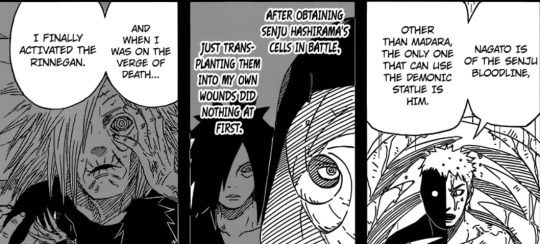
Ch. 606, where Madara's awakening of his Rinnegan is recalled, thereby beginning the Prophecy at all.
As we can see with these panels, the Prophecy is what begun Jiraiya and Madara's unknowing clash, that would lead them both to shape their own and each other's disciples, even if the way Madara acquired his could be more described as pawns, they still followed Madara's philosophies through him or Obito masquerading as him that would go on to shape the entire conflict of Shippuden. But, how did these disciples of theirs clash and intersect?
Chasing Parallels: The clash & intersection of their disciples
I genuinely think one of the most compelling cases for this ship is the fact that their disciples not only define the protagonists and antagonists of the story, but directly correlate with the prophecy was given by Gamabunta to Jiraiya that saw Madara himself as the antagonist. That is, the prophecy of the Child of Prophecy.
Let's take into account the students that Jiraiya had, first of all, who were labeled the child of prophecy:
Nagato
Minato Namikaze
Naruto Uzumaki
Conversely, we also have to factor Madara's own disciples, definitely including those Obito took on in Madara's name:
Nagato
Obito Uchiha
Sasuke Uchiha
Alright, but what are these three in relation to the Children of Prophecy? Where do the parallels and intersecting between Jiraiya and Madara's disciples begin?
Nagato:
What we know from the point above is the fact that discovering the Rinnegan in Nagato was what impelled Jiraiya to take on the Ame Orphans in the first place. Three years that would prove instrumental to the plot, that would shape Nagato's worldview as influenced by Jiraiya himself. But, how did Nagato get those Rinnegan in the first place?
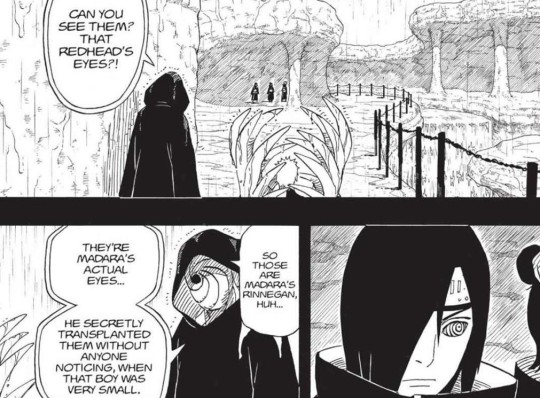
Ch. 606
Those eyes? They're Madara's, implanted at birth intentionally in order to keep them while Madara was waiting to be resurrected, and speculated by Minato.

Ch. 559, when Madara makes his first appearance.
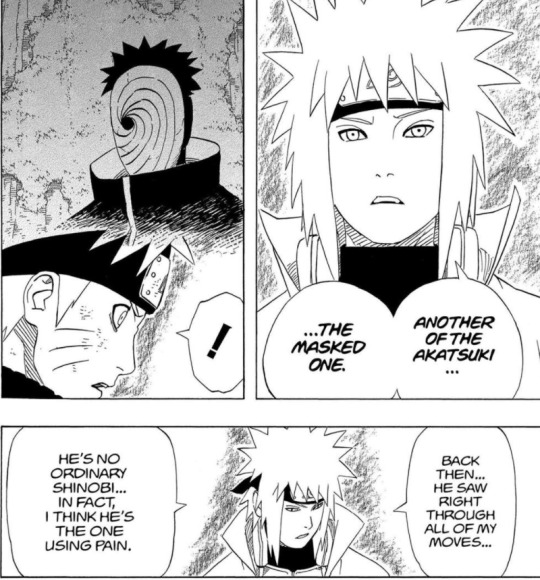
Ch. 440, when Naruto met his father during his fight with Pein.
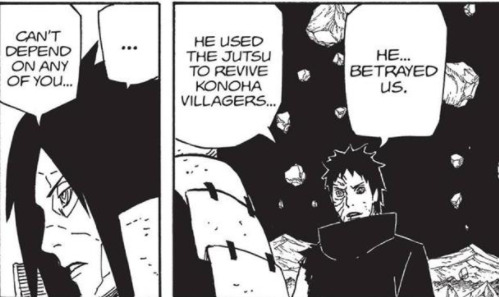
Ch. 601, where Madara and Obito discuss Nagato's betrayal.
What would go on to occur is the fact that, not only did Madara's Rinnegan cement the bond Jiraiya had with the Ame trio, but also shape them - especially Nagato - significantly. That conflict would go on to further the story in ways it wouldn't have if Jiraiya had never taken on the Prophecy and become one of Madara's most enduring yet unknown antagonists. Just as Madara would become the unseen antagonist of Jiraiya's life and his ambition connected to the Prophecy.
Minato:
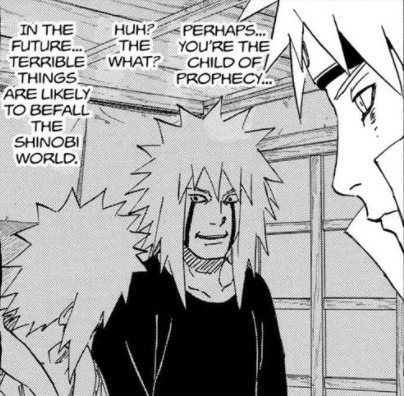
Ch. 503, when Jiraiya speculated that Minato himself might be a Child of Prophecy, too.
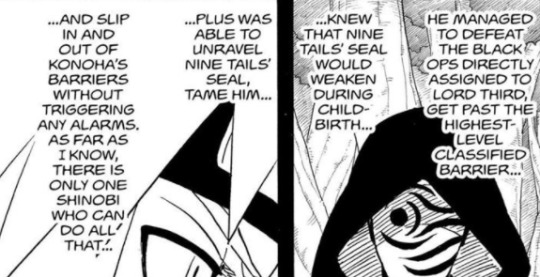
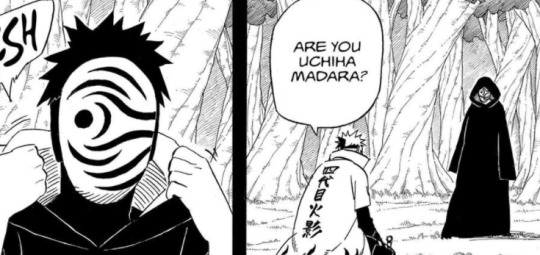
Ch. 502, when Obito - posing as Madara - clashes with his old sensei.
In yet another encounter, Minato - who was Jiraiya's student before the Ame trio - faces off with his former student he believes is Madara, which is fitting as Madara was one of the only known people in existence known for being able to tame bijuu with his Sharingan. Let alone being able to make a summoning contract with the infamous demon fox himself.
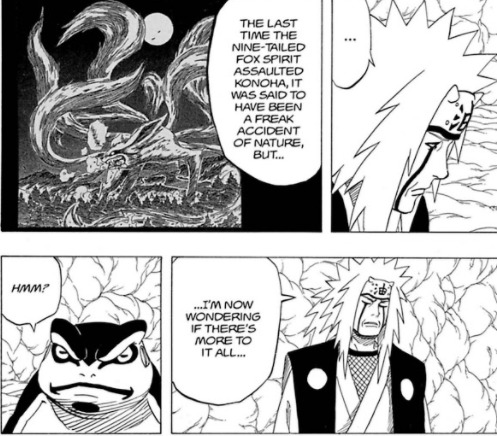
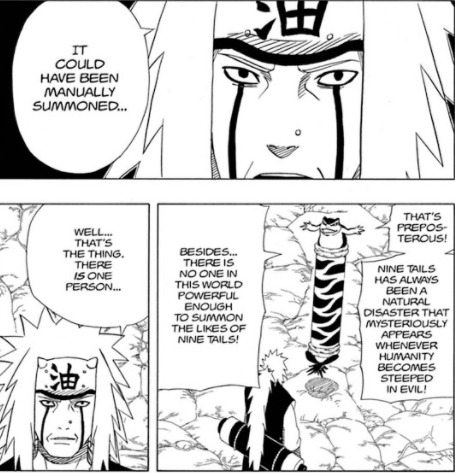

Ch. 371, which is also, coincidentally, the first image of Madara shown outside the statue at the Valley of the End ever seen in the manga.
Jiraiya, too, correctly guesses this hunch that Minato made but clearly couldn't convey to Jiraiya himself on account of being dead. But, like his master, Minato correctly presumes the person he's facing is Madara even if it's not Madara himself. But, well, we all know where that goes with Obito becoming "Madara", and all...
Naruto:

Ch. 437, when Ma calls Naruto the Child of Prophecy for the first time, something likely gleaned from Gamamaru or Jiraiya.
As the main protagonist, it's only natural that Naruto would have the most clashes out of the three, especially compared to Nagato or Minato. But still, they are notable and extremely defining. Remember to keep in mind, Nagato's path as Jiraiya's student, as someone who was shaped by him and later Madara through Obito, his encounter with Naruto is the most significant because of how much Nagato was shaped prior by the Second Shinobi World War that Madara typified in his nihilistic philosophy, then Jiraiya, then again by Madara's views through Obito. This clash - not the battle for Konoha itself - is the closest we truly come to them bridging the gap due to how untouchable Madara is by Naruto's will, which calls for this example.
But, as the main protagonist, Naruto contends with Madara's philosophy more than just once. He does it twice, in fact.
Naruto and Nagato:
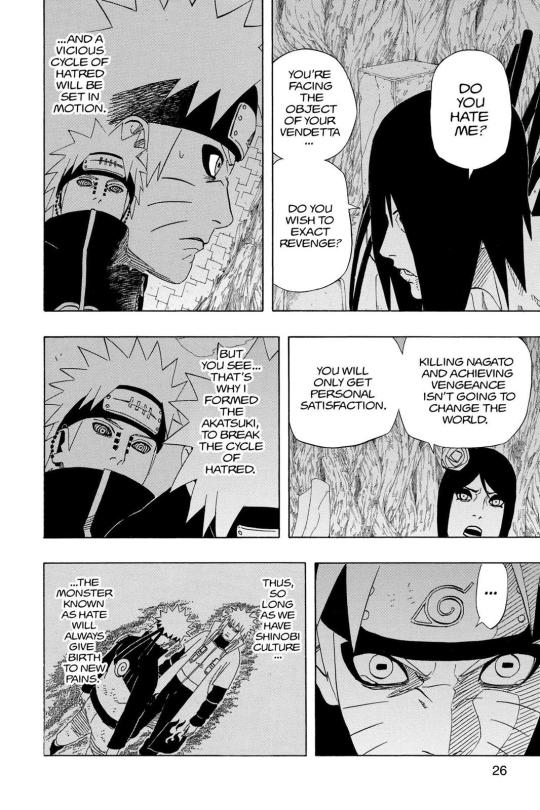

Ch. 444, at the beginning of Naruto's confrontation with Pein where the clash of Jiraiya and Madara's ideals truly shines.

Ch. 602
Remember, the core of Nagato's philosophy is a closer reflection of Madara's than it is even of Yahiko's, even if Yahiko did form part of Nagato's negative worldview before Jiraiya, Madara's completed it the best.

Ch. 372
The panel that defines Yahiko's philosophy, juxtaposed to Madara's, as shown above.
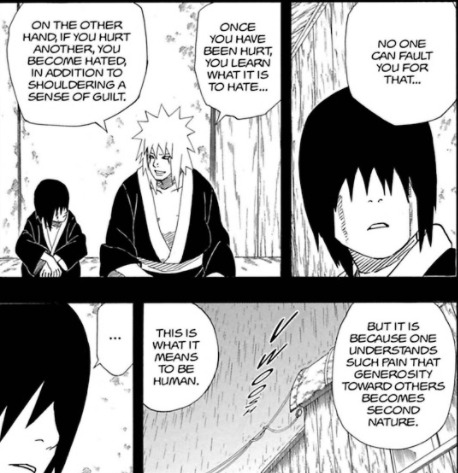
Ch. 372
Continuing on, as seen with what Naruto begins with, it's exactly the same thing that Jiraiya imparted on to Nagato after he felt guilty for killing an Iwa-nin to protect Konan and Nagato.

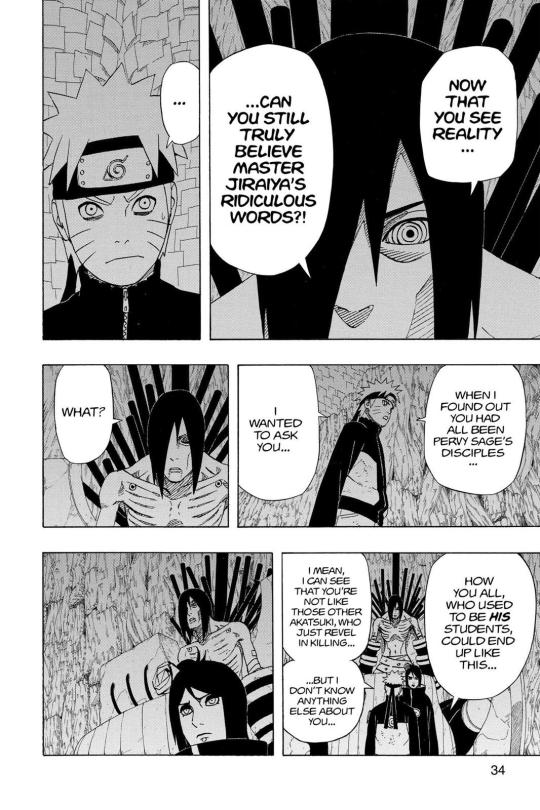
Ch. 444

Ch. 446
Yet, despite all this disparity between them, there were times when both teachers agreed, even if it was at both extremes of this prophetic spectrum.

Ch. 446

Ch. 602
It's a strange agreement, to be sure, but Jiraiya and Madara wanted the same endgame for the world despite how twisted Madara's methodology would come to be. One that ultimately made both clash, even if it was never directly.
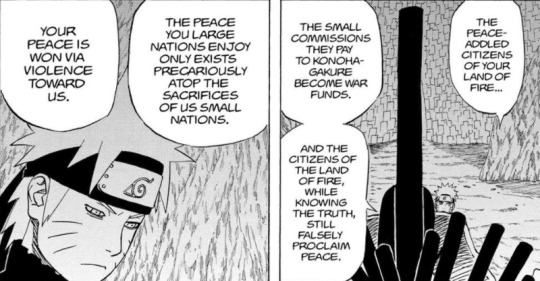
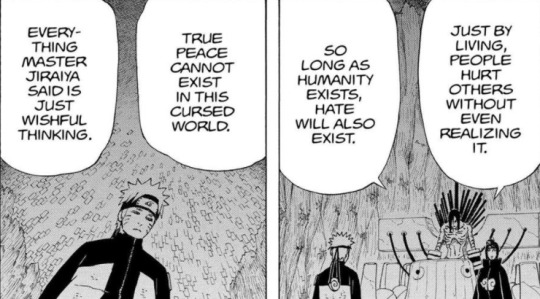

Ch. 447, where Nagato and Naruto come to a proverbial draw in their battle of wills, of their teacher's will versus what Madara would come to impart on Nagato indirectly.
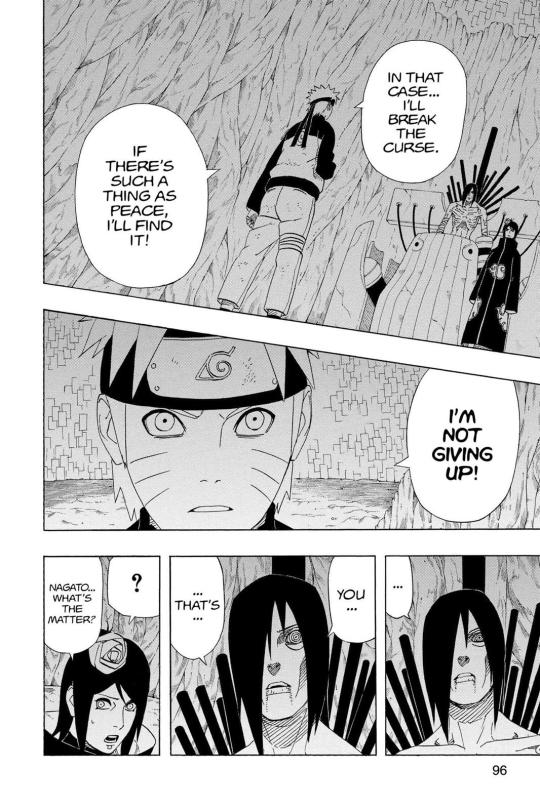
Ch. 448

Ch. 448
Here, we come to the penultimate moment where Madara's hold over Nagato is shattered. The dissolution of his nihilism, the clash that would see Jiraiya win.

Ch. 448, the moment when Nagato provided the inspiration for Jiraiya's titular main character in The Tale of the Gutsy Shinobi, a book that was like the prediction of what was to come in much the same way Morgan Robertson's The Wreck of the Titan would predict the Titanic's demise over 14 years earlier (even if Gutsy Shinobi is a lot more hopeful!).

Ch. 448, where the prediction of Jiraiya's first book would come true through Naruto.
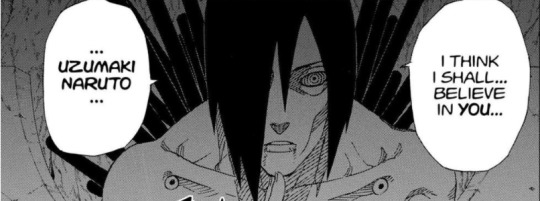

Ch. 448, in what seems to wrap up the prophecy... for now, at least.
Naruto and Obito:
It's during the Fourth Shinobi World War that Naruto and Obito - Minato's student, whom was Jiraiya's before that - finally clash with each other after Obito becomes the 10-Tails' jinchuuriki. Naruto and Obito were alike, once, before Madara broke Obito and conferred upon him his nihilism.

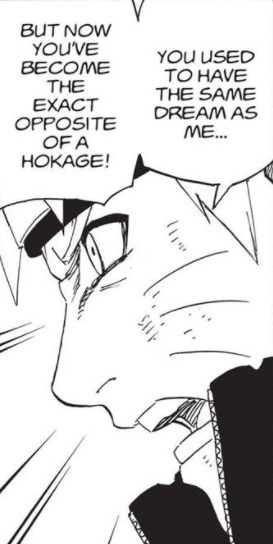
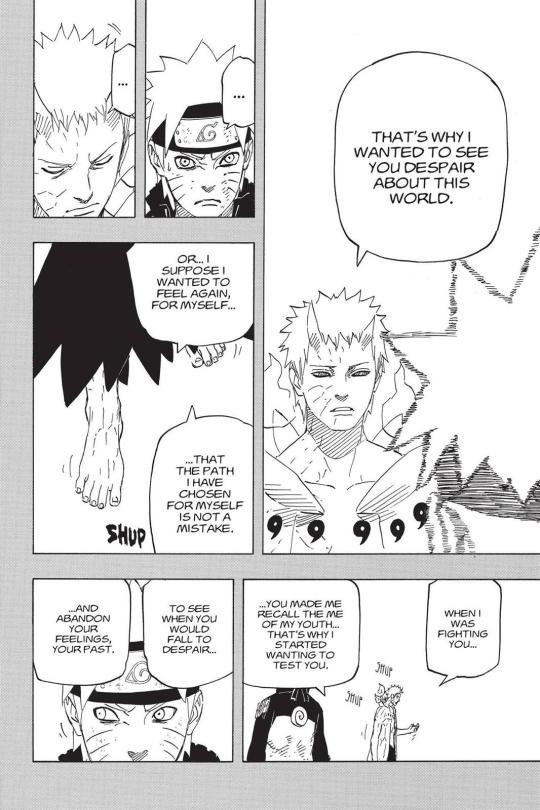
Ch. 653, where Obito outright admits to wanting to test Naruto, to pit Madara's (that he deludes himself into thinking is his own) nihilism against Jiraiya's teaching, that bolstered and matched Naruto's hope for peace in the world. A path that Jiraiya further inspired Naruto to take.


Ch. 653
Like Nagato before him, Naruto bears an uncanny number of similarities to Obito. And like Nagato, he was someone who believed and wanted peace in the world who was indirectly inspired by Minato to seek that peace through the same teachings that Jiraiya conferred.


Ch. 653, where Naruto explains what it means to be Hokage the opposes Obito's, a definition that didn't come from out of the blue.
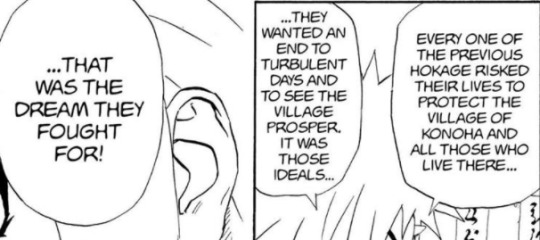

Ch. 159, where Jiraiya defines what it means to be Hokage that matches Naruto's, that transfigured Naruto's initial dream of wanting to become Hokage for the sake of acknowledgment to what it really is: a shinobi who walks before his comrades and protects them.
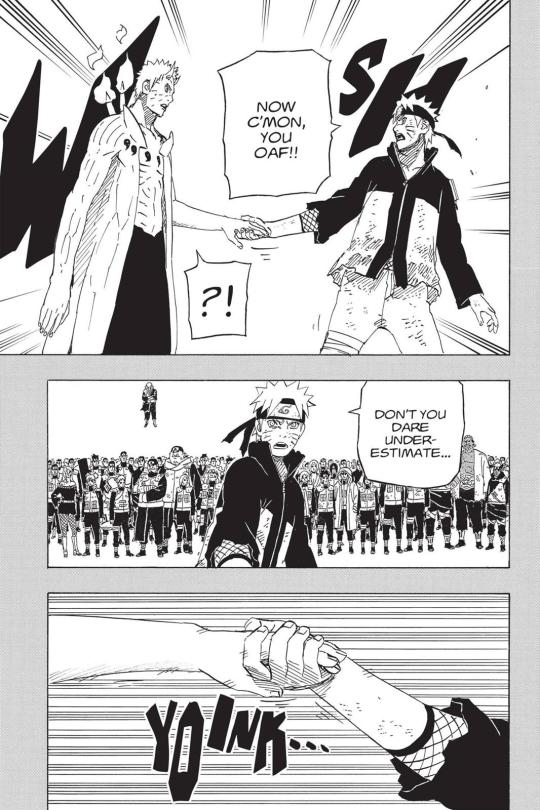
Ch. 653
And like Nagato before him, it was through Jiraiya's teachings that Naruto was able to pull Obito from Madara's darkness and fulfill yet another leg of the Prophecy. Another battle that Jiraiya spiritually won against Madara, even after his death.
Another Intersection: "Madara" & Sasuke
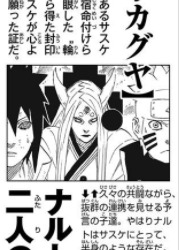
"As Sasuke was the reincarnation of Indra, his was a person with a destiny that was attached to the seal of Kaguya. From the SAge of Six Paths, he awakened the Rinnegan and the key to the seal…That was the evidence of Sasuke’s heartfelt [effort] and desire in wanting to rescue the world.
While jointly struggling for a long time, outstanding cooperation was shown for the children of prophecy. As expected, it was Naruto and Sasuke, similar to being half [of each other’s] bodies."
- Fourth Databook, Sasuke entry (Scan & Translation)
As written in the 4th databook, Sasuke, too, is considered a child of prophecy and makes this intersection equally relevant. While this isn't quite an example of Jiraiya and Madara's ideals pitted against each other, I think it belongs here.

Ch. 396, when "Madara" first takes Sasuke under his wing after his battle to the death with Itachi.

Ch. 397
And here, Tobi introduces himself as Madara, yet another complicated entanglement that would lead to Sasuke, a child of prophecy, also being indirectly manipulated by Madara.
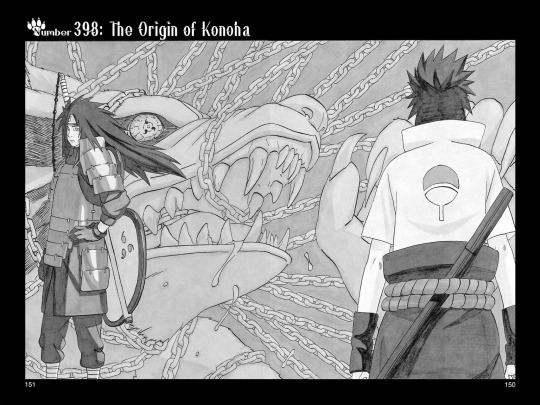
Ch. 398
Even the cover chapter art for chapter 398 emphasizes the change that "Madara" makes in Sasuke, in influencing like he had Obito before him.
Now, it's rather pointless to summarize what's said, as it essentially boils down to "Madara" telling Sasuke about the truth of his brother, the Uchiha Clan Massacre, and his own backstory. Through chapters 396 to roughly 402, in telling Sasuke the truth - much in the way it had been revealed to Obito himself before him - was he changed. Not forever, but what was made apparent was that Sasuke became aligned with "Madara", his philosophy and aims, even if it wasn't to the same extreme as Obito.

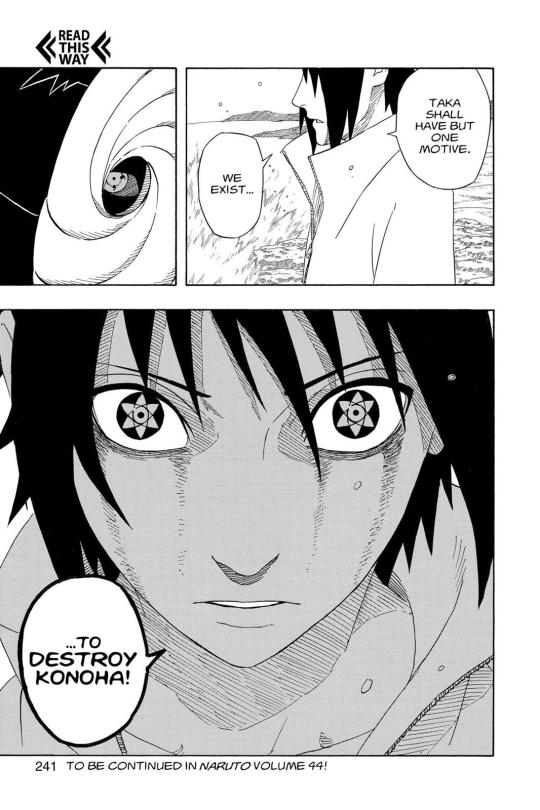
Ch. 402, when Team Hebi becomes Team Taka.

Ch. 626, during the flashback of Hashirama telling of his past with Madara.
And like Madara before him, Sasuke seems to come full circle and inherit the same role Madara had as antagonist, adopting Madara's will.
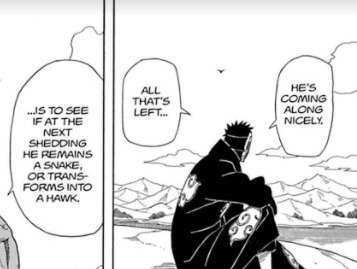
Ch. 371
All according to "Madara's" original plan.
SNS Parallels: Sasuke as Madara, Naruto as Jiraiya
Another major crux of this analysis, aside from the Prophecy and the intersection of their ideals and disciples, is that Sasuke is likened to Madara and Jiraiya to Naruto. In breaking tradition, Sasuke isn't like Orochimaru despite being groomed as a new vessel and Naruto to Hashirama, despite Orochimaru being Jiraiya's narrative parallel and Hashirama Asura's former transmigrant before Naruto.
Sasuke was never meant to be like Orochimaru
Something made abundantly clear was the fact that Sasuke was never meant to be the next Orochimaru. Sasuke himself drives this point brutally home.
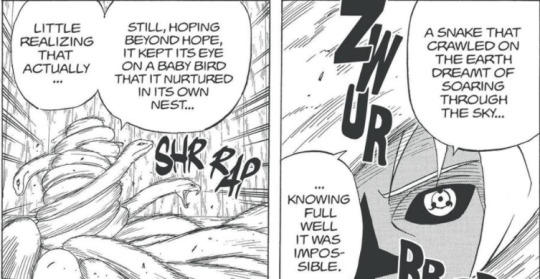

Ch. 344, when Sasuke breaks free of Orochimaru's control.
As we see here, Sasuke himself completely rejects the notion of being the next Orochimaru, both literally and figuratively, comparing himself to a fully-fledged hawk that the snake - Orochimaru - couldn't control. Before this, he tears apart Orochimaru's character, degrading them (though, I doubt that needs to be put here).

Ch. 345
And as the chapter proves, the only way Sasuke could ever be like Orochimaru is through becoming their next host, which doesn't happen.

Ch. 346, where Sasuke is the one who is the victor and absorbs Orochimaru, overpowering them.
Simply put, where the generational parallels go, the very narrative refutes the notion that Sasuke is like Orochimaru, at all. Aside from being the level-headed geniuses of their generation, they're nothing alike and cease to ever be such a consideration. (Not that I think it's a bad thing. The fact that Orochimaru exists outside of the generational parallelism Kishimoto locked many of the characters in enhances the poignancy of their character, not diminished it, especially as such a fascinating antagonist acting of their own accord - not destiny or fate - in Part 1.)
In fact, this goes beyond just Sasuke absorbing and destroying Orochimaru. There's another noteworthy comparison to be made. Now, as I'll state below, Team 7 was meant to be the Neo-Sannin the next generation. However, the text again blows a hole in that assertion.
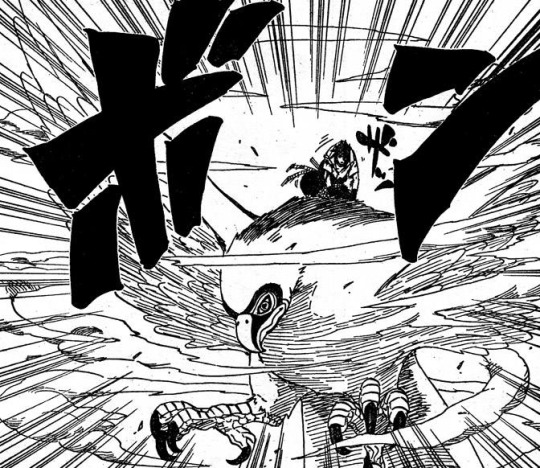
Ch. 477, when Garuda first makes his debut as Sasuke's secondary summon.
As we all know, Sasuke is the only known character in the whole of Naruto with not only one, but two summons. Now, in a previous meta I've written, something that is vital to understand that is that the Sannin's summons are extremely important motifs for their characters. Not only does it tie them in to their folkloric counterparts inspired by the Tale of the Gallant Jiraiya, but it also defines many of their techniques and aesthetics (such as Jiraiya being a Toad Sage or Orochimaru's serpentine affinities and ninjutsu). However, as inheritors of their motif, Team 7 also inherited their summoning contracts with their respective sage regions, especially with specific summons (Aoda the snake for Sasuke, and Gamakichi the toad for Naruto). Again, though, a wrench is completely tossed in this motif with the introduction of Sasuke's second summon, the hawk known as Garuda.
What's important about Garuda's inclusion and the fact that it makes Sasuke the only known person with two unique summoning contracts in the Naruto universe is the fact that Garuda's appearance correlates with this period in Sasuke's development where he moves away from being in Orochimaru's shadow to spreading his wing and becoming a hawk, closer and closer to being the next Madara, the true person he was meant to excel past.

Madara's entry, Third Databook.
Another noteworthy fact, too, is that Madara is connected to hawks through his hobby of falcontry. While it might not seem like much, with his own brother's connection to crows, it establishes a link between Sasuke and Madara that fleshes out a connection to hawks. The same hawk motif Sasuke would become better associated with, as much as Madara is, too, in many fanworks.
Sasuke as the next Madara
However, there is one character that Sasuke is compared and considered the next iteration of, and that's Madara himself.

Ch. 309, Kurama and Sasuke meet for the first time.
As it likely doesn't need to be said, as Kurama had once been Madara's unwilling thrall, even before the plot with Asura and Indra transmigrants, Sasuke was likened to Madara. But, it's not the only time this comparison is made.
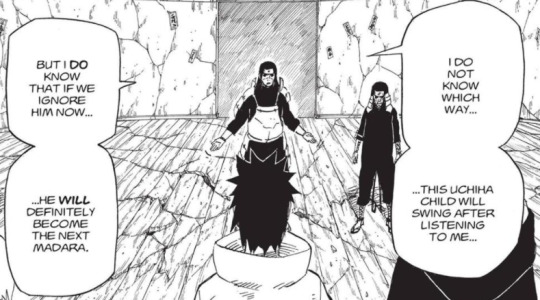
Ch. 620, where Hashirama - Madara's childhood best friend - outright calls Sasuke out as possibly being the next Madara.
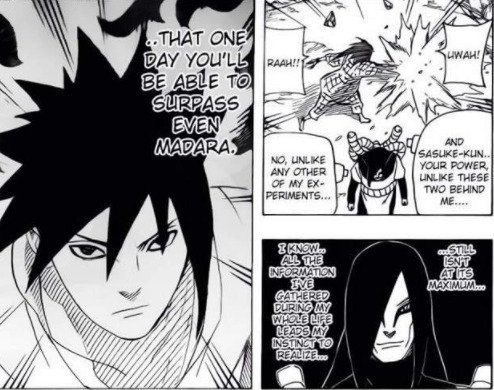
While I don't quite know the chapter, Orochimaru - the one who didn't turn out to be Sasuke's parallel - outright compares Sasuke to Madara.
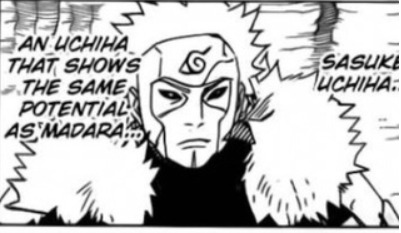
Another unknown, but here, Tobirama - another lifelong enemy of Madara - further emphasizes Sasuke as being like Madara.
With Sasuke not being like Orochimaru, and admitted to being like Madara by the Sannin themselves, the verdict is clear: Sasuke is identically similar to Madara - as confirmed by his contemporaries and enemies alike. Hell, even Hashirama likens him to his younger brother, Izuna.
The verdict? Sasuke is like Madara, hands down.


Ch. 657, when Madara notes Sasuke's straight tomoe pattern in his EMS.
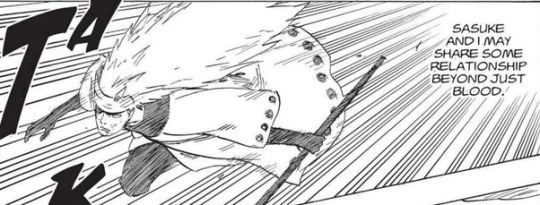
Unknown chapter, but Madara again notes the bond between him and Sasuke goes beyond blood.
Naruto being like Jiraiya

Ch. 245, during Naruto and Sakura's reunion, which means Tsunade and Jiraiya's as well after 2.5-3 years.
As I've affirmed above pretty exhaustively, Naruto's philosophy and ideals mirror Jiraiya's almost exactly. To the point that Tsunade, Jiraiya's long-time friend and fellow cellmate, sees Naruto as being almost exactly like him.
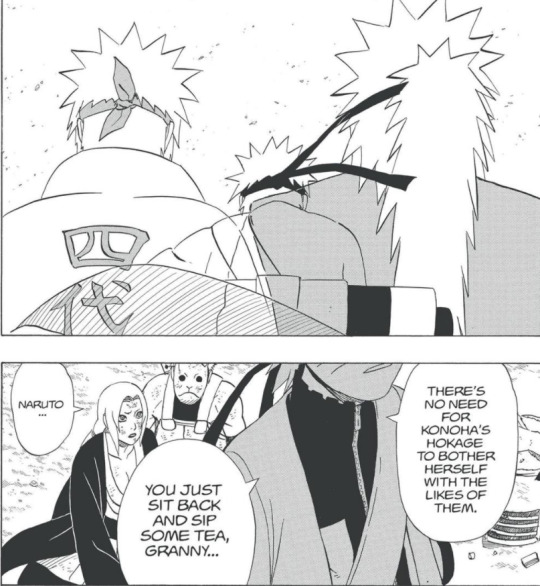
Ch. 430, during Naruto's return to face off against Pein
As we can see with Naruto's arrival to the battlefield of Pein's invasion, one of the first things on Tsunade's mind is how Naruto seems to manifest the very will and dreams of his predecessors by protecting Konoha - seeing the backs of Minato, Jiraiya's student, and Jiraiya's, too.

Again, an unknown chapter.
Now, don't get me wrong, I'm willing to concede that, yes, Naruto has been likened to Hashirama before. While official material like this exemplifies it, I think it's important to keep in mind that Naruto being likened to the Sannin as Neo-Sannin has been around longer than the transmigrant plotbunny ever has. Let alone comparisons between Naruto to Hashirama outside of the predestined reincarnation cycle.
Essentially, given the extensive parallels between Naruto, Jiraiya, and his students, it's clear that Naruto has more parallels and ideological similarities with Jiraiya than he does with Hashirama, despite being on the same reincarnation cycle as the Senju.
More than just that, event the significant goals he failed with best parallel between Jiraiya and Naruto than Hashirama and Naruto.
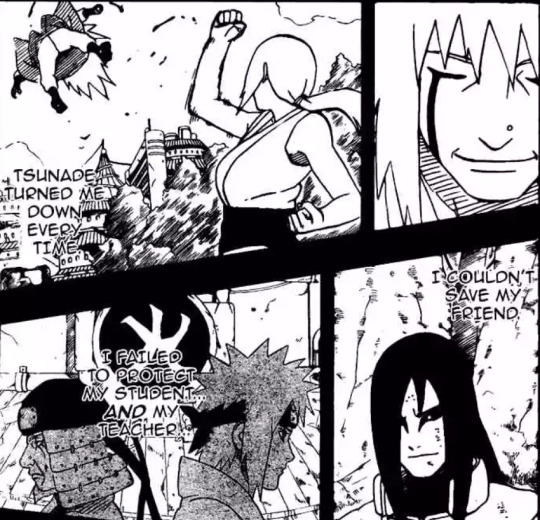
Ch. 382, when Jiraiya reflects on all the major failures in his life.
Now, with this list of failures in mind, how do they parallel Naruto so precisely?
"Tsunade turned me down every time." = Sakura, similarly, turned Naruto down despite there being a false positive. Seeing as she's Tsunade's parallel, this is damning.
"I couldn't save my friend." = Naruto, too, wasn't enough to keep Sasuke from defecting for Orochimaru.
I failed to protect my student... and my teacher." = While Naruto didn't have any students by this time, he did lose Kakashi, initially, during Pein's assault.
With this in mind, it's impossible to think that Hashirama parallels Naruto more than Jiraiya, his counterpart as a Neo-Sannin and someone whose life circumstances were uncannily similar.
But, come what may...
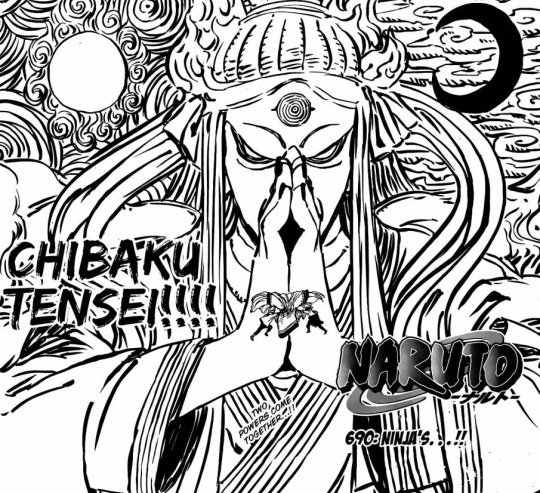
Ch. 690
...Naruto and Sasuke are the ones who fulfill the Prophecy, together, following in the footsteps of those who came before them. Two men who either realized, or came to terms with their failure in trying to bring world peace.
Headcanon: Rinnegan evolving from the Sharingan
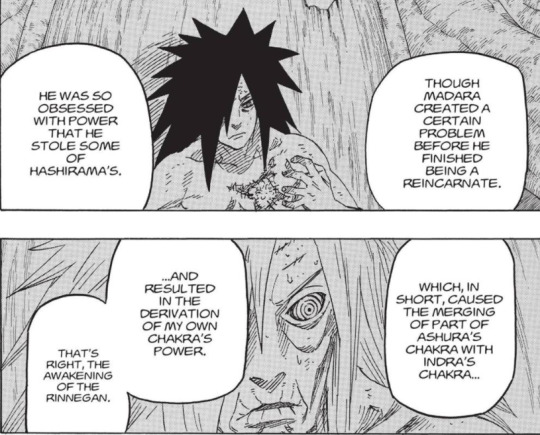
Ch. 671, when the Rinnegan are awakened
So, if one considers that the Rinnegan are an evolved form of Sharingan, that could mean that they could retain some characteristics. While I can't prove anything, this is a headcanon I've had of Madara's Rinnegan for quite some time.

Unknown chapter that divulges how Sasuke could see Itachi's memories after he was transplanted with his brother's eyes.
Now, with all this in mind, in regards to Jiramada since Nagato had Madara's eyes for ~29-30 years (from the time he awoke them (likely 6-9 y/o) to his death), what if the Rinnegan could retain memories like the Sharingan can? And since Nagato's Rinnegan were invoked for well over 3 decades, couldn't it mean that they could record memories like the Sharingan? And if Madara could access those memories of Nagato's once he got his own eyes back and both Jiraiya and Madara managed to survive the war? (Who doesn't love a good Everyone Lives AU?) Well... I imagine it might be angsty, to say the least.
Ways I ship the Thing
To put it expressly, while I've petered my way through the canon connection and intricacies of Madara and Jiraiya's dynamic, in what ways would I ship them?
Everyone Lives AU: Seeing a lot of characters died that people didn't want to die in Naruto, Jiraiya and Madara meeting this way could be compelling.
Madara caused Jiraiya a lot of grief: If there's a compelling angle to any hero/villain ship, it's the fact that Madara was responsible for a lot of Jiraiya's pain and loss through the years. Not only would meeting the other be monumental, but Jiraiya discovering how deep Madara's villainy in his life went - especially with his loved ones and disciples - could be a perfect frame for a post-war meeting & AU.
"Madara" is really Madara: An AU where Madara was really Tobi the entire time could also yield some poignant villain/hero dynamics and struggles.
Purelands: Seeing as Madara and Jiraiya both die in canon, them working through their enmity and differences in an afterlife could also be the subject of fanfic.
Gen Swap: AU's where Jiraiya was alive in WSE/Founders' Era or Madara born in the Sannin's era is also a possibility. With four canon brothers, the Madara of such an AU in the latter scenario could've easily been someone like Izuna.
Redemption: Again, Madara was opposed to Jiraiya throughout the Prophecy. Post-war Madara having to be put under a survived!Jiraiya's jurisdiction could be sweet and complex as hell.
Honestly, regardless as to how this is approached, this entire meta is my ship manifesto; the reason why I ship such an unknown but deeply compelling couple. Not only is it a facet of the tried and true hero/villain shipping trope (or, enemies-to-lovers, enemies-friends-lovers), but the depth these two have in each other is any reason to ship them beyond just acknowledging their canon parallelism as masterminds and influencers on the manga's overarching plot, in Part II especially.
(That, and the hair... Hairpair, anyone? Oh, and the fact that Jiraiya is considered Naruto's grandfather while Madara is - typically - jokingly referred to as Sasuke's (or another family figure) and is a common fandom gag, if not taken seriously.)
Basically, this ship is deep as hell and defined a lot of Shippuden's canon despite how little it's acknowledged.
#jiramada#jiraiya#madara uchiha#sasuke uchiha#naruto uzumaki#orochimaru#my meta#republishing this because i made it BETTER
2 notes
·
View notes
Text
Why The End of Rey and Kylo Ren's Story Is So Disappointing
Darkness rises, and light to meet it.
(Another article deconstructing the why of the unsatisfying ending with a REYLO focus / source below)
With the Star Wars sequel trilogy now concluded with The Rise of Skywalker, fans everywhere now know how Rey and Kylo Ren’s story comes to a close. Those who have long shipped "Reylo" and yearned to see "Bendemption" finally saw it happen, but the film doesn't quite do the work to earn those moments, and forcing these issues highlights how profound the thematic disconnect between TROS and its predecessors. What started out as a compelling dynamic between protagonist and antagonist in the The Force Awakens and The Last Jedi was unfortunately derailed in the last act, delivering an unsatisfying conclusion to Rey and Kylo Ren's relationship.
A Knight and a Scavenger
(...)
They spend all of The Force Awakens and most of The Last Jedi being enemies, and as presented on paper in all three films, there’s simply not enough build-up to sell the romance that the final film wants to go for. Not even The Rise of Skywalker fully commits to this concept, because the first half of the film is so focused on Rey’s struggle with her burgeoning Dark Side power, and her big team-up with Ben at the end is cut short because the movie also wants to get to the “all the Jedi live in you” finale, which Ben has nothing to do with. Perhaps moving towards a romance in Episode IX was always the plan, but the way it’s realized here, what’s supposed to be their heartfelt final moments together are lacking the emotional weight they needed.
A Shattered Alliance
(...)
The Force connection they share is exploited further in The Rise of Skywalker, but rather than being used to explore their dynamic, it’s used more for the sake of spectacle. Consider how small moments of physical exchange in TLJ (some drops of water materializing on Kylo’s hand) are replaced with lightsaber duels happening in multiple locations. Cool? Sure. But the deeper meaning of why this bond was even established feels subdued here, particularly when Rey and Kylo destroy Vader’s helmet, not in a conscious cooperative act, but accidentally mid-battle. The thematic coherence of this aspect of their relationship feels lost in the chaos of the film’s frantic plotting and roller coaster pacing.
A Broken Promise
But with two major plot turns, The Rise of Skywalker tries to get Rey and Kylo back on the path towards not just reconciliation, but romance.
The first is the reveal that Rey is Palpatine’s granddaughter, which once again sends Rey into an existential crisis about her parentage, but this time saddling her with the same issue Kylo had: a grandparent on the Dark Side. Now her bloodline does matter, and it's no coincidence that Kylo is the one who reveals this information to her. After all, he is a tragic example of how the weight of an important lineage can turn someone to the Dark Side -- and now Rey is being crushed by it. While the attempt to create another mirror between the two makes sense in theory, it comes at the cost of being completely divorced from Rey’s character journey in the last two films. The shape of her own destiny she forged across the trilogy, the idea that her origins don’t need to define her capabilities, is destroyed. Becoming the Light Side’s new hero despite “having no place in this story” was powerful. Revealing that she did have a place in it all along feels like a shortcut to ensure Rey has another connection to Kylo rather than a natural evolution.
The second is Kylo’s rushed redemption arc, which makes no sense in the context it appears in. After Rey and Kylo's duel on the Death Star wreckage, a defeated Kylo gets another chance to turn to the Light with some help from the memory of his father, and this time he takes it. However, nothing that has happened to Ben in the previous movies or this one indicates that this would turn him. His opinion of his father hasn’t changed in any way since he murdered him, and his mother reaching out to him through the Force sadly falls flat given that they haven’t shared any scenes across the whole trilogy. Rey says she wanted to “take Ben’s hand” after healing him, and while that is an effective call-back to TLJ that could possibly get him to reconsider his morality, it also feels like a small piece of what should’ve been a larger arc across the movie. Instead, everything related to Ben’s turn has been shoved into this one scene. It’s not enough to communicate why, after all the horrific things he’s done, now is the moment he is redeemed.
Rather than getting us invested in an ending that felt thematically connected to the previous films or even coherent on its own terms, The Rise of Skywalker shuffles its pieces to get where it wants to go without justifying how it gets there. Ben joins Rey in her duel with Palpatine, running in with his father’s blaster, and all of his darkness is simply washed away. The idea of their connection being based on how they were representations of the Light and Dark Sides, how one came from nothing to become the last hope for the Light while the other was born from the Skywalker legacy and still turned to the Dark, is tossed aside. After such a strong first two acts, Rey and Kylo deserved a better conclusion, one that truly solidified the emotional bond these two characters were supposed to share.
(...)
------------------------>
read the full article, link below,
I don’t agree with everything the author says, but I find it interesting that Reylo, now that it has happened is deemed worthy of a greater effort at story telling, compared to where we stood a few years ago. Obviously it does not change anything to the final movie now.
SOURCE : ign.com/articles/2020/01/03/why-the-end-of-rey-and-kylo-rens-story-is-so-disappointing
172 notes
·
View notes
Text
The Skywalker saga is coming to an end and I spent virtually four years hiding in the shadows to avoid the discourse (™). Well, to that I say no more! Rey isn’t a Skywalker! Finn is important even if he’s not a Jedi and Ben Solo is going to redeem himself!
And to rest my case below is a long thread about the Skywalker Lightsaber, the place of each character in the sequel trilogy and their narrative function. Buckle up!
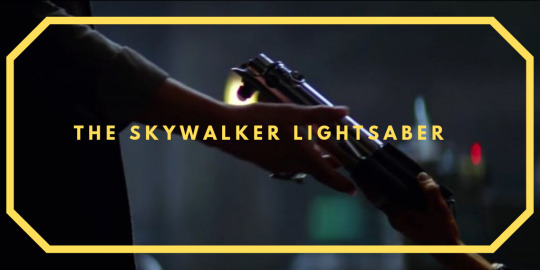
First, let me postulate that--in-universe--the Skywalker lightsaber, throughout the trilogies, is the mythical sword of power, the Excalibur of a galaxy far far away. Some characters are meant to care for it for a short period of time while others are meant to wield it.
On a meta-level, we can advance that the Lightsaber stands for the Skywalker saga itself. This is why salty fans complain that toys packaging read “Rey's lightsaber” instead of “the lightsaber that once belonged to Anakin then lost by Luke.”
It bothers them that A GIRL inherited/took the lead of Star Wars.
Without further ado, let’s jump into the meta and explore the symbolic function of the Skywalker Lightsaber in The Force Awakens and The Last Jedi.
In TFA, Maz Kanata is our Lady of the Lake, and perhaps it’s not a coincidence she lives by a body of water in a quasi-medieval setting. Like Obi Wan before her, she’s the custodian of the Lightsaber and her function is to bestow the magic laser sword to the protagonist.

The how or why she’s gotten the sword isn’t important in the grand scheme of things. The important thing is she’s here to kickstart the adventure.
But where Luke was simply handed the sword by birthright in the OT, Rey actually receives “a calling” as well as a Force vision of things past and things to come. Through Maz’s words, the audience understands that Rey is our protagonist.

Unlike Luke, Rey freaks out and runs away thus refusing the call to adventure, one of many steps on her Campbellian monomyth journey. Paradoxically, running away is how Rey is definitely sucked into the story since it’s in the forest that she meets Kylo Ren.

Ultimately--in-universe--her latent Force powers awaken thanks to this fateful encounter, and Kylo becomes--from a narrative standpoint--the reason why Rey joins the fight/the story. There is no hero without a villain but we’ll come back to that later.
Meanwhile, Maz is pulling the same kind of trick with Finn. I don’t know if you remember but before TFA Finn was marketed as the one wielding the lightsaber and people were lead to believe he would be Force sensitive.

In the following sequences though, Maz isn’t bestowing the lightsaber to Finn, she’s giving him the task to deliver it to Rey. This is how Maz lays out to the audience that Finn is our Deuteragonist. This is also how she prevents him from running away.
In the OT, it’s Han who was the deuteragonist, and the next few scenes where Finn is given the opportunity to wield the Legacy lightsaber, inform us on his own heroic journey.

Although he demonstrates great bravery during his fight against “Nine”, Finn is bested and almost immediately relieved of the sword. It’s only after the Resistance saves the day that he picks it up, alongside a weapon he’s more comfortable with, a blaster.

We are to understand that Finn’s destiny isn’t to become a Jedi or follow Rey on her path to becoming one, instead, he’s destined to become “a big deal in the Resistance”.
After that, we don’t actually see the Lightsaber before the end of the movie. But before we dive into the symbolism of the epic fight on Starkiller base, we need to discuss the role of our third main character: Kylo Ren.
Kylo Ren, formerly known as Ben Solo is the only son of Han and Leia, nephew of Luke and grand-kid to Anakin thus making him the heir to the Star Wars legacy. He’s also obsessed with Darth Vader, which makes him the most meta character of the trilogy.
His function in the ST is...complicated. On one hand, he’s the antagonist, the character who opposes and causes trouble for the protagonist but if we analyze his relationship to the Legacy Lightsaber, we quickly that the lines are blurred.
Because the movies are told from Rey’s POV, in TFA all we are given to see are his actions, but not his motivations--although J.J. gives the audience plenty of hints, but I digress--The first time Kylo lays his eyes on the Legacy Lightsaber, his reaction is visceral.

Some called it entitlement, and in a way it is. But at the same time, it is not--the Lightsaber/Star Wars does indeed belong to his family. In this scene, it is the first time that Ben Solo actually embraces his Skywalker heritage!
It’s important because the first time we saw him, he sliced Lor San Tekka for implying he’s a Skywalker, then we witnessed him murdering his father in a desperate bid for embracing the dark side for good (which he failed).
Moreover, the Skywalker lightsaber isn’t a relic of Darth Vader, it is Anakin’s sword, a sword of light he lost when he committed to the Dark Side of the Force. In this context, it shouldn’t be something Kylo Ren is seeking. Yet...
Anyway, Finn--who for dramatic effect kept the lightsaber instead of giving it to Rey when they met in the corridor--readies himself to face Kylo Ren, whom we know he’s terrified of, in spite of his previous failure with that weapon.
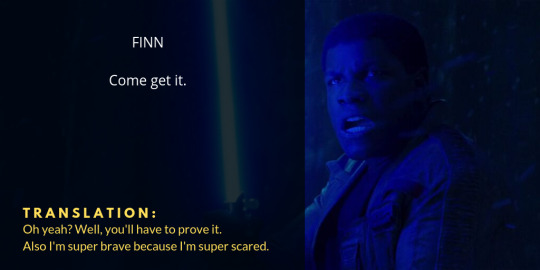
By allowing Finn to wield the lightsaber a second time, the writers allow us to witness another step in his character progression. But once again, Finn is not destined to win this fight, and the lightsaber lands into the snow.
This is another exciting Excalibur moment--Like the fabled blade in the stone, the Legacy saber starts vibrating until it chooses its champion, flying past Kylo into the hand of Rey.

Follows a beautifully choreographed fight in the snow, chock-full of raw emotion and symbolism that culminates when Rey slashes Kylo’s face and--for a split second--considers ending his life. But the force and the directors have other plans.

The movie ends on a sort of bittersweet note for me as we see Rey embarking on her journey to Ahch-To. On one hand, she receives the blessing of Leia, the “other Skywalker twin” who places her faith in her.

Yet, on the other hand, we also see her afraid as she reaches Luke and presents the Lightsaber to him as if she was a mere messenger and not the hero of the story.

Thankfully, our Lord and savior Rian Johnson (I’m not being sarcastic- turn around right now if you hate him and TLJ) picks up the story right there to assuage that fear.
Allow me to digress before I dive into TLJ. Imagine J.J. Abrams, wearing Jedi Robes handing over the Skywalker Lightsaber to Rian. “Here. Star Wars is yours now. Go play with it.” (or see alternative image below)
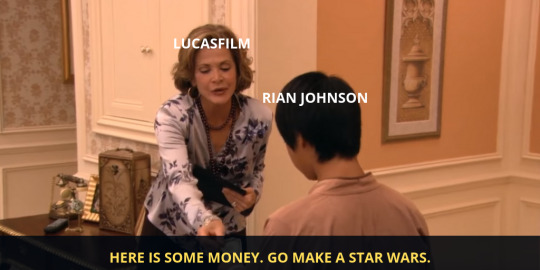
The first thing that Rian does is to take his toolbox and take the lightsaber apart: What is it made of? What part goes where? Do I need all the parts for it to work? How can I make my own lightsaber?
TLJ is a very meta Star Wars movie, even more so than TFA. It’s also a character-driven story,
and presumably, that’s why so many people didn’t “get it”. They either expected the characters to stay static or they wanted a completely different story.
However, as we’ve seen, Rey was destined to become a Jedi, Finn was destined to be a part of the Resistance, and Kylo was destined to not be a mustache-twirling villain.
In the second installment of a series, you need to shake things up, push the characters further down their path. And that’s exactly what Rian does. Rey hands the Skywalker lightsaber to Luke, who simply throws it away.
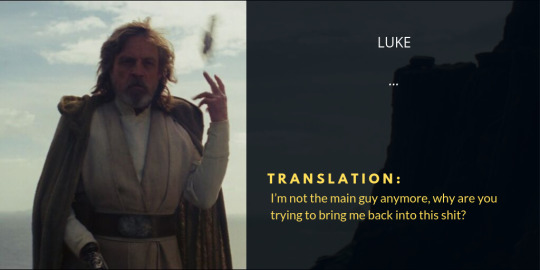
The Last Jedi is a movie about self-realization, that gesture leads Rey to question her place in the narrative. Until now she convinced herself that her mission was to bring Luke back to the Resistance so he can defeat Kylo Ren and magically fix the galaxy.
She picks up the lightsaber and tries to convince Luke to come back or to train her because she’s afraid and doesn’t know what to do. She can’t go back to Jakku and has nowhere to go on top of being magically linked to a guy who killed his dad.

The next scene with the Lightsaber occurs after the second Force Bond. Between Luke’s stubbornness and her conflicted feelings towards Ren, she decides to work out her frustration. First, with her staff, then--as her confidence in her abilities grows-- with the Lightsaber.
It’s a way to show that Rey is slowly starting to understand that she needs to take her destiny into her own hands, and the response won’t come from outside of her. That realization though isn’t made to happen further down the line.

Before that, there are two more times where Rey is trying to hand out the Legacy Lightsaber to a Skywalker before taking it for herself and embracing her destiny.
1 - Right after her fight with Luke. Now that she understands that Ben Solo’s turn to the dark side stems from a big misunderstanding she gives one last chance to Luke to be the savior of the galaxy everyone expects him to be. But Luke has his own demons to fight before being ready (we’ll come back to it)

2. When she ships herself to Ben. Symbolically she’s reiterating that he’s the Skywalker of the trilogy and that his place isn’t by the villain’s side. She wants him to be good (and to climb him like a tree)--But Ben also has his demons to slay before being ready.

The next thing, they’re standing in front of Snoke. Immediately, the raisin-faced villain takes the Skywalker lightsaber away from Rey and tries to manipulate the narrative, in an effort to render both Rey (and Kylo) powerless.
First, he coldly explains that he laid out a trap to both Rey and his apprentice, and that he’s going to discard Rey because she doesn't have a drop of Skywalker blood in her veins and thus isn’t relevant to the story.

Whether he lies about the Force bond doesn’t matter because--in the end--Snoke’s obsession with the Skywalkers is his downfall.
It’s no coincidence Kylo kills Snoke with his grandfather’s weapon, a light side weapon. In that moment it’s not about power, it’s about saving someone he cares for, like Vader saved Luke.
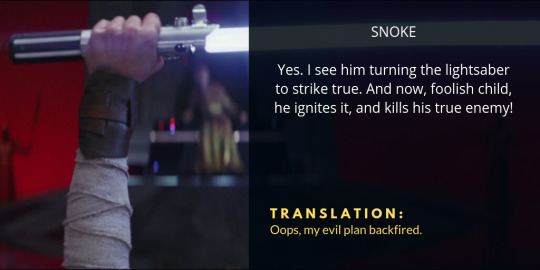
And the weapon he so desperately wanted to keep for himself in the last movie? He floats it right back to her, proving once and for all he wants her to live and be a part of the story.
Ensues the battle with the praetorian guards where our protagonist and our antagonist fight back to back for dear life. For the second time Ben Solo saves himself thanks to the Skywalker lightsaber that Rey throws back at him.

But then…as he looks down on Snoke’s corpse, Ben/Ren pockets silently the lightsaber.
The thing is, we’re at a crossroads in the story. This is the second episode of a trilogy and both Rey and Kylo have made tremendous progress in their self-realization journey. But they’re not there yet.
In this moment we understand that Kylo has bigger demons to fight before being ready, whilst Rey needs to fully embrace her role in the story.
Her heart breaks as she listens to Ren’s plea to join his side “because nobody else believes she’s worth it because she’s not a Skywalker”. He wants her to be bad (and marry him)--she wants to save everybody.
She reaches out and calls the Skywalker lightsaber to her but this time, the weapon “hesitates” and Rey and Kylo end up locked into a game of Force tug of war.

Eventually the Lightsaber breaks. In this moment are we to believe that Rey isn’t worthy? Or that Ren/Ben is maybe not so unworthy, and there’s still hope for him?

Fast forward to Crait, where Luke appears to face the First Order alone armed with a laser sword. Many wondered why he’s using the blue Skywalker lightsaber instead of his own green lightsaber.
Well, one answer of many is that not knowing what went down on the Supremacy, Luke appears to the FO--and the audience--as if he’d listened to Rey’s plea on Ahch-To and took the lightsaber she was presenting him.

On a meta level the battle against his nephew is Luke’s climactic moment, and we’re here to witness his last and most daring heroic moment in the saga, where he accepts to embody the galaxy’s “last hope” once more.
Not unlike Obi Wan’s before him, Luke’s sacrifice ensures that Rey becomes “the new hope”.
Some found Luke’s death cheap and tacky, but I found it very moving and thematically relevant to the concept of birth, death and rebirth evoked on Ahch-To. By becoming one with the Force like his mentor before him Luke became more powerful than before.
With that in mind, is it a coincidence that the title of the next movie is The Rise of Skywalker? I think not. Now we need to discuss the last shot where the Skywalker Lightsaber appears. Rey holding the two shattered pieces in her hands while Leia delivers words of hope.
That’s some powerful imagery here because Rian spent a whole movie shaking up Star Wars and he knows it. That’s why he shows the shattered lightsaber. It is “broken” but not beyond repair. You just need to reassemble it.

At the same time, it is no longer the “Skywalker lightsaber”, it’s about to become something new, something else, something I’m very much looking forward to discovering in December.
255 notes
·
View notes
Text
i’ve been watching ffxiv cutscenes for the main story (pushing thru heavensward right now) and i’ve been thinking of stuff for my wol lately so i guess now’s a good time to introduce them a bit :-)
here’s a link to the og meme: Self Insert Development Meme
1. Does your insert have a name that’s different from yours? Does the name reflect their character in any way, or is it just because it sounds nice? How did you come up with it?
wol’s currently nameless... i can’t use with the usual “eren” as per the naming conventions of each ffxiv race (i will use wol!eren to indicate, well, My WoL). maybe if i wanted them to be a hyur i’d be able to, but i’ve been hopping back and forth between aura (raen) or viera (veena)...
edit (8/4): i keep forgetting to update this lmfao,, but my wol’s name is momo and they’re an aura (raen)!
2. Does your insert have a very strong relationship with a f/o, maybe more than one? Tell us a little about the dynamic they have! This can be a bond that’s romantic, familial, or platonic, anything - even an enemy would count as a strong relationship!
there’s only maybe one person who’s aware of the character(s) that i’m maybe. MAYBE. maybe. looking at (eros Do Not Interact). no names as i refuse to acknowledge/perceive them in any manner.
but, the relationship’s still in the works,, i’m thinking it’s a lot of it’s gonna have to focus on positions of power/hierarchies... maybe a bit of slowburn... for spice.
i feel like any rom relationship i could build might. be slow burn. oops!
3. Who in their canon are they closest to? Who would they drop everything to come help, if anyone? Who’s the person they’re least close to? Who would they most likely not get along with, if anyone?
in terms of story, i think wol!eren’s really close to alphinaud; i get familial vibes from him (and actual wol spends a very large chunk of time with him as well)... but personally, i’m thinking estinien. yea he’s a bit of an asshat but he’s cool (but ig that makes wol!eren a bit of an asshat too)
when it comes to who wol!eren’s not close with... honestly, anyone that abuses their position of power for selfish and harmful reasons at the expense of people go on the hit list. but even then, if the character’s one of the main characters/shown often then it’s like... i’d have to think about it a little more. happens a lot
4. Does your insert have a backstory? Tell us about it! How does their backstory, if any, define who they are? How does it reflect their relationships now? Their hopes and dreams?
hmm much like my other s/is, wol!eren delves on their past often despite their preaching of looking forward. a hypocrite they are!! (/s) a lot of my self ships also delve on like. “same hat” so... honestly they’re just kinda going with the flow and walking wherever they feel is an easy path. they’re a pretty passive person despite the role they’ve been given.
5. Does your insert have any magical talents or otherwise special abilities? Are they passive, like the ability to befriend animals, or dangerous power that the villains want? Or if they're evil - any powers the heroes want to stop?
as per the narrative, they were chosen by hydaelyn and have the echo. however, they’re also extremely perceptive. they can typically tell whether someone has good intentions or not. the issue is that it’s always a feeling and they usually don’t have anything to prove their claims. as a result, they rarely say anything about it. it's not really a “power” but it can certainly be helpful.
6. Do they fight? What’s their weapon of choice? Do they stay on the sidelines? What would it take for them to get off the sidelines? Revenge? Saving a loved one? What’s the motivation for them to fight, or to stay OUT of a fight?
i plan on wol!eren being a summoner! or maybe not exactly a summoner, but something to do with magic being used offensively. they hate getting their hands dirty so they’ll just blow you up instead.
they mainly fight because it’s their duty/obligation to fight, but had they not been in the position they were, they’d have sooner leave combat and live off the grid. nobody really knows this because they never voice it -- it also wouldn’t be good for a warrior of light to say “yea i hate my job and i don’t really care about some of you”, you know?
(7/18) edit: with the help of my ffxiv mutuals, i’ve decided to make wol!eren a black mage :) it’s definitely fitting for their character.
7. What kind of clothing style do they like? What would they never be caught dead wearing? What’s likely in their closet right now?
REALLY DARK CLOTHING. if they show any skin when they don’t have to, they’ll Perish. i intend for them to wear the void ark clothing for magic users but much like everything else, that’s subject to change. clothing that’s aesthetically pleasing and easy on the eyes is good.
8. How do they fit into their canon world? What’s their role to play, if any? Do they have a big destiny? Or do they more live as a side character that’s helpful for the protagonists/antagonists?
literally the protagonist but very much desires to be a side character. because they like playing a supporting role more than the main role, they live in “anonymity.” kinda. it’s just hard when the group you’re apart of and gods?? know literally just about everything you’ve been doing.
9. Their favorite foods? Colors? Activities? What do they enjoy in life? How do they express their joy for things they like?
they will. eat just about anything they’re given, even if the food’s not super great (like a raccoon.....). they don’t really have any particular favorites and if they do, it’s likely to be meat or basic, easy-to-make dishes.
just anything that’s dark/muted. color colors (blues, purples, etc.) are their favorite.
they very much enjoy doing absolutely nothing, especially now that they’re so busy with working. if they’re free from work even if it’s just for a few seconds, you will find them sleeping. Lazy
if they like something, they’d never say it out right. extremely private and closed off person, so unless you’re really close with them, you’d never know if they truly liked something.
10. Their least favorites? What don’t they enjoy in life? How do they deal with being presented with things they don’t like?
literally just anything that inconveniences them. they want things to run smoothly so they don’t have to deal with anything they don’t have to. when something arises that stops them from fulfilling their duties, they’re get irritated. they also just, not the biggest fan of people and socializing.
11. How easy is it to make your insert angry? Sad? How easy is it to twist their emotions into negative things? By contrast, how easy are they to cheer up? What can brighten a bad day?
they’re easily prone to negative emotions, but it’s not “major/serious” since they’re mostly out of touch with their emotions anyhow. if it gets really bad, they kinda “shut down.”
one way to get under their skin is confront them about personal matters, but you can cheer them up if you have a good sense of humor! alphinaud’s helped with that, albeit unintentionally more often than not.
12. Is your insert a loner, or do they prefer crowds? Do they warm up easily, or do they tend to take longer to befriend others? What kinda people do they get along with? Who are they likely to be uncomfortable with?
i think i did mention earlier that wol!eren really doesn’t like crowds. it takes them a very long time to genuinely consider someone as a friend. sometimes they might not even acknowledge someone even if said person tries their hardest to befriend them. and there’s not really a type of person who they’re really “uncomfortable” with (spoilers they’re always uncomfortable with everything asjfhsd), but i guess if i had to answer, it’s just anybody with potentially harmful intentions?
they have. Trust Issues™, if you will.
13. What are your insert’s goals? Their hopes and dreams for the past/future/present! Do they intend to achieve no matter what? Could anything stop them, big or small?
in the past, they wanted to live a comfortable life as a recluse where they can do things without the eyes of others watching... and they still do, but now they’re too accustomed by the presence of people to truly achieve that. after their duties as a wol (if they’re ever completed honestly), they’d probably pull a cloud final fantasy and start a delivery service or something like that LOL
14. Does your insert have any family relations? How do they get along? How do they disagree? Is it a biological family? Adopted? Or is it found family? How did this family come together, if it was one of the last two?
sssomething like that? so far i’m thinking they come from a family of arooound 5. 2 siblings + parents. they have a younger sibling who’s a miqo bard mercenary and an older elezen (?) astrologian currently working somewhere in ishgard. debating on who their parents are but all of them were kinda... “picked up” and put into a family.
the “parental figures” were desperate to have a family but they had little knowledge of how to care for children. needless to say, the environment was not one to flourish in.
miqo brd is kinda like robin hood where he steals from the upper class to give to the poor because he refuses to allow people who’re in need suffer due to a lack of resources. on the other hand, the ast is the elezen who wants nothing but peace. the downside is that he’s very aggressive with his ideals and follows people like the archbishop, thordan.
edit (7/18): wol!eren wasn’t tied to their family biologically, but due to their questionable actions and words, they cut ties with their family and started traveling alone. it was extremely difficult but because they didn’t stay in confines of their own home, they were able to meet the scions and the not.
alphinaud and alisaie are like their siblings. they share a surprisingly a deep, unspoken familial bond with the three because of all the adventures they went on together. wol!eren’s been caught acting like an older sibling to the two.
15. Does your insert have any enemies? What’s that dynamic like? Why are they enemies? Did they ever get along in the past? Is patching up differences out of the question for the future?
much like the actual in-game wol, i’d imagine that anybody that wants to stop the wol in their tracks are considered “enemies.” i haven’t gotten that far into ffxiv to really name characters though,, tba.....
16. Free question space! Ask whatever you want to know!
if ur into ffxiv and u’ve gotten this far down... thank u :) and talk to me abt ur wols or ur ffxiv faves in my inbox maybe?? 👀
#eren chats#long post#<that is not a joke this got really long#info subject to CHANGE but i wanted to throw what i've been brainstorming here#i'm gonna go continue heavensward now#gonna start 3.1 :~)
7 notes
·
View notes
Text
Ways to Salvage the Dragon Egg Princess With a Sequel
(Originally posted on Pillowfort two weeks ago.)
In a previous analysis post on The Dragon Egg Princess, it was made clear how messed-up Koko's identity conflict was. Koko was raised as a human princess, but later discovered she had hatched from a dragon egg, was the last of the dragons, and was now expected to become "a dragon". Supposedly, she had to become "a dragon", including assuming dragon form, because it was her true self or "destiny". The book's conclusion, given its build-up, was unsatisfying and only made sense if there was off-screen child abuse forcing Koko into a particular identity.
However, The Dragon Egg Princess can still be salvaged with a better-executed sequel.
--
----
A Few Book Flaws
Remauld (Koko's magic teacher) and the namushin (forest spirits), as my analysis makes clear, are one of two things: some variety of “misguided” or “overzealous”, possibly blended with obliviousness or patronizing attitudes, or simply...immoral.
Some of the flaws of the previous book are how neither the namushin nor Remauld are ever acknowledged as bad or flawed in any way. In fact, not one person even dislikes them. Secondarily, the namushin (including their magic council representative, Zaki) and Remauld have pretty flat characterization and motives, a likely casualty of the book having too many characters and too little time to develop characters that would logically be better-developed or important. Most of Remauld's characterization is "wise magic teacher who admires dragons and pushes Koko into her "destiny"". The namushin are simply "kind, helpful forest spirits popular among humans that have a habit of simply appearing on the scene", and are so underdeveloped one never even sees their direct dialogue.
Furthermore, Koko's whole pressure to assume her "destiny" as a dragon, "represent" dragons, and be the princess of dragons seems pointless when she's the only one left. Dragon culture exists only as a fossil, so who would acculturate her? Who would she rule over?
----
The Bad Guys
Due to their questionable motives and ways of going about them, Remauld and/or the namushin could be perfect antagonists for a sequel, and the new role would theoretically help develop their personalities. Luzee, the evil fairy antagonist of the first book, isn't exactly a fleshed-out "round character", but even she has more characterization than most of the good guys, exempting the protagonist, Jiho, Koko, and arguably the bandit leader Micah (who felt largely superfluous to the book, anyway).
Namushin
The cataclysmic war which ended in the death of all dragons (barring Koko) was initially caused by humans being afraid of supernatural creatures (including dragons) and attacking them, and Luzee secretly stoking their fears to gain more power. Koko outright mentions, just once, the cause of the first war as one reason people might not want to be a dragon. Based on this, and the fact over nations don’t have big magic forests like Joson (fantasy-Korea, basically) and have very little if any magic or magical places left, the Namushin could have a motive to attack humanity.
Although one could write them as wanting to kill all or most of humanity, the most internally consistent motive is wanting to kill those people of other nations who haven’t been incorporated into the Nackwon’s armies and are associated, even loosely, with the destruction of magical areas. Or, they merely want to restore the magic forests of the other nations, at all costs, as quickly as possible, with no care for what humans suffer and die in the process. (the spirits and spirit vines from The Legend of Korra could be a good parallel.)
They might want Koko because dragon magic could uniquely accelerate the process, or Koko would be useful to scare off their human enemies, and they believe they have Koko’s loyalty.
It’s mentioned the Joson people don’t have their own special sections in the Nackwon’s human armies: they’ve already been integrated into the general forces of the Nackwon because they are “magic, just like the Nackwon”. (something like that…) Therefore, the namushin could very well exploit Koko’s status as the princess of Joson to get the entire Joson nation as allies or give themselves political legitimacy quickly.
Remauld
Luzee initially tried to drain Queen Nanami (the queen of the dragons)’s brother for power, but he turned back into his dragon form and fled. He’s not mentioned outside a brief explanation in the magical viewer. Remauld said dragons were his friends and seems really enthusiastic about it. What if Remauld was Queen Nanami’s brother, who’s been in human form all this time? What if he felt like, as the only dragon left, he had to be a de facto parental figure for Koko and thought her human parents inadequate for the task? What if he didn’t want the pomp and restrictions of being the ruler of dragons, or was too much of a coward to confront Luzee if it could be avoided?
There’s also the possibility Remauld was Queen Nanami’s mate, which would have similar characterizations. Dragons can shapeshift into humans, but what about vice versa? Koko can shapeshift leaves into toads, among other magical features, so it’s plausible that Remauld is skilled enough to change his very body, or Queen Nanami changed his body herself. It’s stated dragons breed rarely, and they were lucky if one egg was laid per year.
Hundreds of years ago, Queen Nanami had to give a dragon’s egg to the powerful fairy Luzee as a source of magic so she could protect them against humans, before her turn against the Nackwon entirely and attempt to kill all dragons. Knowing the urgency of creating a dragon’s egg, Nanami may have chosen a shapeshifted Remauld to bypass whatever reproductive difficulties had, because a half-dragon's egg made quick was better than a full-dragon's egg too late to be useful.
Perhaps Remauld never told Koko that he sired her egg because he was ashamed that he, a lowly (compared to dragons) wizard who idolized dragons, had to be her father. Perhaps he wanted to maintain what he thought was a comforting illusion Koko was a full-blooded dragon, who only hatched weirdly because of a “dragon’s instinct to survive making it appealing to its caretakers” (his explanation for why Koko hatched as a scaly humanoid that quickly became indistinguishable from human). If Koko’s father was a magic-human, one could easily blend Koko’s identity conflict into a more coherent dual-species theme of uncertain or mixed identity.
---
Koko With Actual Subjects?
If Koko had actual subjects, her identity would be a lot more important, so Koko learning of some other dragons is a good idea for a sequel. Perhaps the namushin never found them because they live in the other nations, and their data-collecting is spotty in the nations that don’t have magic forests. Perhaps it’s hard to tell a dragon in disguise from a real human unless they’re using magic, and it takes a lot of luck to perfectly observe a candidate at just the right time. However, the dragon-folk are fully aware dragons don’t exist as a separate culture or faction any more, or their loyalties are to human rulers, or they think of themselves as “humans who can turn into dragons” rather than the reverse, so they think Koko has no authority over them.
Koko initially assumed she was special and necessary because Joson loyalty allegedly had a trace of dragon’s blood, and the Namushin (evasively) told her she was related to Queen Nanami. Perhaps, five hundred years ago, some dragons defected from the dragon military and hid as humans. (perhaps in nations other than Joson---a good excuse to explore those in the next book) Because humans so feared supernatural creatures and dragons, they hid their true natures for many decades, even generations. They told their children who grew up among humans they had exceptional magical ability (or even the “unique ability to turn into dragons”) because they were descended from the illegitimate children of Joson royalty, who, yes, had traces of dragon blood, which were especially obvious in some people by sheer luck. Since the Joson royals sure don’t want word of indiscretion getting out (especially if the dragon-humans still live in Joson) and will use force to maintain secrecy, they should keep their unique abilities secret.
These “humans who can turn into dragons” would be an interesting foil for Koko. They would delight Remauld, frustrate him, or both. They would provide Koko an alternate identity option she hadn’t even considered under the yoke of crushing expectations/child abuse. And since Koko is not only “a dragon”, but also “a dragon princess” and “princess of Joson”, she may very well be a poor choice to represent these “dragon folk” as a whole, because she shares little in common with them. The “dragon folk” might not even be (or look) Joson in their human forms. However, one could also present them as second-generation or even twentieth-generation immigrants from Joson, only distinguishable from their neighbors at all because of their preference to interbreed with other dragon folk. (It’s unclear how long it takes for dragons to breed, or whether their human forms affect generation times.)
The above idea might allow something thematically similar to, “the only Tsimshian (Native American tribe with the lowest or second-lowest population) in the nation, who was adopted by Caucasians, and who figures Tsimshians are extinct, is brow-beaten into identifying as Tsimshian in the ‘purest’ way for Magic Reasons and is conflicted about it, but then realizes there are modern Tsimshians with very different backgrounds and identity expressions a few states away and must grapple with her identity again”.
One could probably combine “Remauld and/or the namushin are villains” with “Koko learns of humans-that-can-turn-into-dragons” into the same plot. Perhaps the namushin flush out the “Dragon Folk” in the process of restoring other nations’ forests/attacking other nations, or basically expand their tree-based “satellite vision” into other nations now that the immediate threat of Luzee is gone. (Luzee breaking out would make the Namushin’s projects pointless, after all; she would simply take over the world again and probably kill all namushin)
#Analysis#Books#Fantasy Books#Fantasy#Identity Conflicts#Identity#Literary Analysis#Meta#Dragons#Writing
1 note
·
View note
Link
With the Star Wars sequel trilogy now concluded with The Rise of Skywalker, fans everywhere now know how Rey and Kylo Ren’s story comes to a close. Those who have long shipped "Reylo" and yearned to see "Bendemption" finally saw it happen, but the film doesn't quite do the work to earn those moments, and forcing these issues highlights how profound the thematic disconnect between TROS and its predecessors. What started out as a compelling dynamic between protagonist and antagonist in the The Force Awakens and The Last Jedi was unfortunately derailed in the last act, delivering an unsatisfying conclusion to Rey and Kylo Ren's relationship.
A Knight and a Scavenger
Even before we learn exactly how they will be connected, The Force Awakens portrays Rey and Kylo as diametrically opposed. Both are introduced wearing masks, yet Rey’s lasts for barely a minute while Kylo doesn’t take his off until two thirds through. Rey is a scavenger on a backwater planet, scraping by on her own skills to survive, while Kylo is a major leader in an autocratic military organization about to achieve dominance in the galaxy, a position he secured via his connection to his grandfather, Darth Vader. Setting aside how we now know the story ends, as initially presented in TFA, Rey is from nowhere and Kylo is our heir apparent to the Skywalker name.
We understand by the midpoint of the movie that Kylo has a familial connection to all three of the Original Trilogy heroes, and yet he has inherited none of their heroism. Rey, meanwhile, has everything to gain from selling BB-8 and doesn’t, and within seconds of learning his importance to the Resistance is ready to put herself on the line for it. Rey looks to Han Solo as a potential father figure; Kylo cuts him down because he’s his actual father. Their opposing views are even literalized by the massive canyon that tears them apart after their duel in the snow. But there is something that does connect their characters in this film beyond their strength in the Force: their fascination with mythic iconography. Rey, a starry-eyed collector of Star Wars memorabilia (she lives in an AT-AT!), and Kylo, a vindictive child who prays to the burnt husk of Vader’s helmet. Both of them are children of the OT’s legacy, but one pulled to the Light, the other drawn to the Dark.
They spend all of The Force Awakens and most of The Last Jedi being enemies, and as presented on paper in all three films, there’s simply not enough build-up to sell the romance that the final film wants to go for. Not even The Rise of Skywalker fully commits to this concept, because the first half of the film is so focused on Rey’s struggle with her burgeoning Dark Side power, and her big team-up with Ben at the end is cut short because the movie also wants to get to the “all the Jedi live in you” finale, which Ben has nothing to do with. Perhaps moving towards a romance in Episode IX was always the plan, but the way it’s realized here, what’s supposed to be their heartfelt final moments together are lacking the emotional weight they needed.
A Shattered Alliance
Before we ever hear the term “Force Dyad” from Palpatine, The Last Jedi effectively communicates that Rey and Kylo are intrinsically linked just as much as they are fundamentally opposed. The connection Snoke forges between their minds through the Force gives us some of the film’s best scenes, and it’s understandable why they are drawn to each other after Rey’s journey into the Dark Side cave. After learning what might have been the worst possible answer to the driving question of her own existence, Rey lays her cards on the table. “I’ve never felt so alone.” Her emotional vulnerability is conducive to her reaching out to Kylo, a man who feels just as dejected by his origin story as she does by hers, and to mistakenly believing that she can turn him to the Light just as much as he hopes to seduce her to the Dark.
This tension (of multiple varieties) explodes in the throne room, with a lightsaber battle against the Praetorian Guards that glistens with passion and rage. The Light and the Dark, for a dazzling moment, unified in purpose. Yet when the battle ends, both of them believed they’ve won the other to their side. Rey begs for Kylo to tell the First Order to stop firing at the Resistance shuttles, and Kylo asks her to take his hand and help him rule the galaxy. Neither of them have changed. They are still opposing forces, and they once again pull apart, literally tearing the Skywalker saber in two during their struggle. Rey accepts her place as the last Jedi, while Kylo doubles down on his darkness by assuming the mantle of Supreme Leader. At the end of the film, even though they briefly united, they end with Rey closing the door on him. If anything, The Last Jedi reinforces their disparate nature rather than subverting it.
The Force connection they share is exploited further in The Rise of Skywalker, but rather than being used to explore their dynamic, it’s used more for the sake of spectacle. Consider how small moments of physical exchange in TLJ (some drops of water materializing on Kylo’s hand) are replaced with lightsaber duels happening in multiple locations. Cool? Sure. But the deeper meaning of why this bond was even established feels subdued here, particularly when Rey and Kylo destroy Vader’s helmet, not in a conscious cooperative act, but accidentally mid-battle. The thematic coherence of this aspect of their relationship feels lost in the chaos of the film’s frantic plotting and roller coaster pacing.
A Broken Promise
But with two major plot turns, The Rise of Skywalker tries to get Rey and Kylo back on the path towards not just reconciliation, but romance.
The first is the reveal that Rey is Palpatine’s granddaughter, which once again sends Rey into an existential crisis about her parentage, but this time saddling her with the same issue Kylo had: a grandparent on the Dark Side. Now her bloodline does matter, and it's no coincidence that Kylo is the one who reveals this information to her. After all, he is a tragic example of how the weight of an important lineage can turn someone to the Dark Side -- and now Rey is being crushed by it. While the attempt to create another mirror between the two makes sense in theory, it comes at the cost of being completely divorced from Rey’s character journey in the last two films. The shape of her own destiny she forged across the trilogy, the idea that her origins don’t need to define her capabilities, is destroyed. Becoming the Light Side’s new hero despite “having no place in this story” was powerful. Revealing that she did have a place in it all along feels like a shortcut to ensure Rey has another connection to Kylo rather than a natural evolution.
The second is Kylo’s rushed redemption arc, which makes no sense in the context it appears in. After Rey and Kylo's duel on the Death Star wreckage, a defeated Kylo gets another chance to turn to the Light with some help from the memory of his father, and this time he takes it. However, nothing that has happened to Ben in the previous movies or this one indicates that this would turn him. His opinion of his father hasn’t changed in any way since he murdered him, and his mother reaching out to him through the Force sadly falls flat given that they haven’t shared any scenes across the whole trilogy. Rey says she wanted to “take Ben’s hand” after healing him, and while that is an effective call-back to TLJ that could possibly get him to reconsider his morality, it also feels like a small piece of what should’ve been a larger arc across the movie. Instead, everything related to Ben’s turn has been shoved into this one scene. It’s not enough to communicate why, after all the horrific things he’s done, now is the moment he is redeemed.
Rather than getting us invested in an ending that felt thematically connected to the previous films or even coherent on its own terms, The Rise of Skywalker shuffles its pieces to get where it wants to go without justifying how it gets there. Ben joins Rey in her duel with Palpatine, running in with his father’s blaster, and all of his darkness is simply washed away. The idea of their connection being based on how they were representations of the Light and Dark Sides, how one came from nothing to become the last hope for the Light while the other was born from the Skywalker legacy and still turned to the Dark, is tossed aside. After such a strong first two acts, Rey and Kylo deserved a better conclusion, one that truly solidified the emotional bond these two characters were supposed to share.
Midway through TROS, Rey says “People keep telling me they know me. I’m afraid no one does.”
Maybe she was right.
30 notes
·
View notes
Text

Every Monday, I gather together the moodboards made by all of you talented writers so that we can start our weeks off with a little artistic inspiration - and you’re invited to participate!
___
Last Monday, our moodboard theme was “Destiny”! Does your protagonist have a fate awaiting them? Does your antagonist wrestle against their predetermined end? Or will your heroes decide how their own stories will go, one page at a time? Catch up on all the prompts and boards from last week!
This Monday, our moodboard theme is “Astray”! Do you have a character who has strayed from the path of righteousness, be they a savior or a villain? What of a character far from their homeland? Or even an animal, lost from the embrace of their former owner? Bring them home today for Moodboard Monday!
Next Monday, our moodboard theme will be “Hospitality”! Do you have a character who opens their home to others? Or someone who shows mercy to others through warm meals and homemade gifts? Perhaps someone whose life was changed by being welcomed in an unexpected place? Give your characters a place to shine here on the homestead next week!
___
To participate in our weekly Moodboard Monday challenges, tag me (@homesteadchronicles) when posting a moodboard that matches the present, upcoming, or former themes. Should you have made a moodboard in the past that matches a current theme, feel free to reblog it and tag me the same as you would with a brand new board. We will be featuring selected submissions on our blog next week for all to see!
#moodboard monday#moodboard#moodboard prompt#character moodboard#oc moodboard#write#writer#writing#writeblr#writers of tumblr#writers on tumblr#writing inspiration#writing tips#author#book#bookblr#novel#story#fiction#character#original character#oc
5 notes
·
View notes
Text
WHO IS THIS MAN?!?!?!
So, as some of you may know, Damien is my favorite Seduce Me character. However, after doing a deep dive into some of the game-related questions Michaela Laws has answered on her Tumblr page, my interest in James was piqued. While all of the incubi have a brute demon father, their mothers are all different. According to her, the brothers’ genealogy was explained as such:
Sam: 50% brute demon, 25% incubus, 25% dragon
Damien: 50% brute demon, 25% incubus, 25% shadow demon
Matthew: 50% brute demon, 50% incubus
Erik: 50% brute demon, 40% incubus, 10% dreamstalker demon
James: 50% brute demon, 30% incubus, 20% unknown
I don’t like unknowns. Unknowns make me curious. So here we are.
I’ve done some digging. As the percentages show, James’ heritage stems farther down the maternal line, likely from his grandparents or great-grandparents. Based on the information in the games and the answers found on Michaela Laws’ page, I’ve narrowed it down to two possibilities. One of these hypotheses has more evidence than the other, but at the end of the day it’s all speculative. Let’s jump right in!
James is 20% fae demon.
There is very little information about fae demons available, but there are some pieces of evidence that could lead us to believe that James is part fae demon. The most obvious trait to point out is James’ green thumb. He is good with gardening and has an affinity for flowers. According to the Otome CD, James says, “The first thing I did was go to a library and read all I could about history, culture, law, and other topics I believed were necessary to survive. A gardening book somehow got mixed in with the books I was reading, but I couldn’t bring myself to ignore it. I read through every page and found myself fascinated with it. Everything was so intricate and detailed. I couldn’t help but read a couple more books on the topic afterwards.” After being forced to learn all there is to know about ruling a kingdom, it’s no wonder finding his way back to nature would grab James’ interest. If I remember correctly, it was Matthew who sounded surprised by James’ ability to alter the wedding guests’ memories. This ability is one that fae demons have been known to dabble in. It is Fae who alters the protagonist’s mind after walking in on the secret meeting. And I know Michaela Laws has nothing to do with this, but when searching “fae seduce me” through Google, a minecraft skin and a sketch of James appears within six or seven lines. I thought that was interesting.
All of these points are all well and good, but there are some counterpoints to this hypothesis. James exhibits no form of specialized elemental magic. Of all the incubi, Erik was the one to combine flowers and magic in the first game. While incubi and succubi genes are dominant, all of the brothers can tap into their other demon powers, regardless of how connected they are to that part of their heritage. Damien, who is 25% shadow demon, can use doppelgangers and manipulate the darkness. Erik is only 10% dreamstalker demon, and can use his power with ease. The two other known fae demons, Twila and Fae, have elemental abilities. Fae can control plants and Twila has wind powers, much of which exhibit themselves when she has a magic flare. Both Fae and Twila have abilities that have to do with the air. They can fly and control wind. James levitates during his final fight with the angel, but apparently all of the brothers can do that. James’ main ability is his quick-learning. While fire and lightning are elemental, this secondary form of magic seems to be common among demons, as shown by both James and Diana during the final battle. This leads me to believe my second hypothesis over the first.
James is 20% angel.
I think this is more likely specifically because Michaela Laws was hesitant to reveal this information once she put it out there. If James were just part fae demon or some other sort of demon that hasn’t been mentioned, it might be a bit more obvious; perhaps even anticlimactic. Michaela Laws is always making connections to angels via James. His route is the only one in Demon Wars to include angels. In the final battle with the angel, James’ sword gleams with “an almost ethereal and god-like glow.” As she discusses why angels are antagonists in the second game, Michaela Laws uses James as the example. None of the other brothers are discussed in that post. Just like Saero, he has “supernatural golden eyes.” Fae demons are more free spirited while angels are stoic and serious. This fits James’ character more.
There are times where demons and angels are shocked by his abilities. Again, Matthew sounds surprised at James’ use of mind-altering powers at the wedding ceremony. During the final battle with the fate-keeper angel, James “formed a large wall between himself and the angel, pushing him back. The angel, unimpressed, tapped the wall over and over in attempts to dispel it, but found it to be impenetrable.” The fate-keeper angel is confused and infuriated by this turn of events. Angels are known for their ability to wipe memories, and holy magic is meant to defend and repel. It might be out of the norm for demons to be apt in these abilities. James is more powerful than his brothers because, whether he knows it or not, he can perform holy magic.
The red and blue indicators for pursuing Suzu and Naoimi in the first game represent chaotic and lawful choices. When comparing each path, we find parallels that lead to comparisons between two brothers: James and Sam. While Sam is hot-tempered, James contrasts his demeanor with a cooler personality. There is even a whole episode dedicated to the two fighting among themselves for the main character’s affections. This shows a clear match between a dragon and an angel. Much like Naomi and Suzu, they are two sides of the same coin.
Naomi & Suzu are the two friends whose personalities clash.
Law & Chaos are two competing forces in the universe.
Trinity & Dragons are company name suggestions, holy vs heathen.
Angels & Demons are two opposing entities.
James & Sam are the two brothers whose personalities clash.
James has this inner conflict where his conscience fights between law and chaos. This manifests itself in James’ desire to be a gentleman. In the Otome CD, he says, “Miss, you are aware that I am a demon, correct? On top of that I am an incubus, a creature who lives and feeds on sexual energy from any creature it can lay its hands on. Despite this I maintain control of myself because I don’t wish to make you a meal to consume. I’ve devoted myself to being the perfect gentleman. Yet, I find my urges harder to control with each day that passes by while I live here.” James constantly has to reign himself in and fight against his demon urges. His chaotic desires offset his lawful tendencies. He has said many times that he wishes to be the perfect gentleman, but never goes into where that notion stems from. Perhaps James is unaware of it himself. Regardless, the inner struggle of demon and angel blood may be a catalyst to this behavior.
If that isn’t enough evidence, look to Queen Istorae, who in this instance would have more angel blood than her son. She is always described as cold and militaristic. Angels in this universe are merely agents of heaven, whose soul purpose is to protect and serve. The wise queen was described as an anarchist among demons. Rather than becoming a matriarchal ruler, she handed the reins over to the Demon Lord. If Christian mythology is at work here, then the angels are more inclined to follow a patriarchal system. Finally, a lingering question I had after playing James’ route in Demon War was why he was locked in a stone destiny to begin with. Why would his mother give up her life force in order to create it? He was already meant to rule, and most of his brothers were content to keep it that way. One of the reasons could be that James had nephilim blood, and would therefore be in constant danger. Locking him into a stone destiny would protect him from angels indefinitely, as only the barer of the destiny can break it.

I see you, James. I’ve got my eyes on you.
Shout-out to @sm-asks for archiving and tagging all of the Seduce Me answers from @thebunnyofevil. You are the biggest star! Also, I’d like to reiterate that these are all hypotheses. I adore the idea that James could be a niphilim, as that adds another layer to his character, but that doesn’t mean it’s positively canon. If there is something I missed, or you want to add to this in some way, I’d love to hear from you!
#seduce me#seduce me the otome#seducemeotome#james incubus#raestro#michaela laws#hannah talks nerdy#seduce me expanded universe#long post#my brain needs a break from these deep dives#i almost titled this post In the Arms of a James-el#it's bad and i feel bad for thinking it#luckily i like catbug quotes more#i'm tired goodnight
30 notes
·
View notes
Note
What’re your thoughts on the trope of a former antagonistic or villainous character changing sides (let’s say not because their ideals/what they’re fighting for changes, but because their ideas about what the best way to achieve that have changed)? I’d love to hear your thoughts on this, as it’s something I struggle with at times with a character of mine (her starting off on the side of the villains, and then changing sides to join the heroes is super important for her arc). Thanks a bunch!
Hello there! Thank you for asking. This is such a fun question!
I usually get a real kick out of antagonist-becomes-friend (or at least becomes temporarily or occasionally non-antagonistic) tropes. I personally think you can split the trope a few ways, depending on specific iterations of it. For example, there’s the complete change of heart, where someone goes “oh damn I was evil and I don’t want to be anymore,” and then there’s the enemy of my enemy is my friend approach, where an antagonist teams up with the protagonist–or at least doesn’t act antagonistically–because they share a common, greater threat, but could lapse back into old habits as soon as that passes.
I’m not entirely sure what sort you’re talking about–it’s a little unclear from your wording–but I’m going to guess you mean they’re a little more anti-hero than outright villain, given that their ideals apparently line up with the protagonist’s, but their methods previously didn’t. Unless you mean the ideals–i.e., “doing bad things,” or whatever–stay the same, but the character hides those intentions and acts like they’ve given up on that? I would say that latter one is actually not the trope at all: that’s just plain villainy and deception. Anyway! A lot more underneath the cut.
At the moment, my partner and I are watching Buffy (I’ve never seen any of it before), and this is a real timely question, because that series has a great example of both kinds of “villain becomes friend (becomes villain again)” tropes in action using vampires. On one hand, you have Angel, who is originally just a normal guy, turned into a vampire with a talent for being wildly sadistic, and then as punishment for that, he gets given a soul. That returned humanity and enforced sense of morality overwhelms him with guilt for all his past crimes, so then he chooses to do good things to make up for it. Of course, throughout the show, his soul flip-flops due to magic shenanigans and he reverts to evil version a bit, but I think that’s an interesting counterpoint to the other vampire: Spike.
He’s just a solidly bad dude, albeit often not a very capable one, and most of the time he’s an antagonist–except for in circumstances where his goals (typically not dying, getting his girlfriend back, whatever) align with the protagonist team’s. We’ve just got up to the part where he’s been fang-neutered, for lack of a better word, so he’s been sulking about unable to bite anyone and turned essentially into everyone’s weird, sullen, harmless roommate (which has been extremely fun). Once he realises he can fight–and kill–other demons, however, he perks right up and actively and voluntarily wants to participate in protagonist team’s world-saving duties, because it lets him be awful again, as long as he’s only awful to demons.
What I like about these two is that they seem to represent two different conceptualisations of morality, but within the same show! Angel is thoroughly a deterministic case: when he has a soul, he is good, and when he has no soul, he is evil. There’s never any wavering either way–he never has a “but what if I chose to be good?” moment when he’s full demon (the implication for the entire show until that point being that vampires can’t and won’t make moral choices), and he never finds vampire sobriety a challenge as a souled being and is overall a soft, sweet guy. Angel is essentially two entirely separate people in one form: a “good” self and a “bad” self, both of which are more or less externally triggered by whoever is cursing him at the time. ***ooh, someone please ask me about Dr Jekyll & Mr Hyde sometime, please, I can talk on that topic for a century***
Spike, by contrast, is a representation of morality as a forever shifting spectrum of choices. I think this is why I find Spike to be a more interesting character than Angel (although don’t get me wrong, Angel is nice and I like him). I like that Spike has such a wide range of emotions and motivations he’s allowed to experience and express, rather than being dictated his sense of self by fate and destiny, so on, and that–at least where we’re up to at the moment in this show–he’s doing “the right thing” (trying to kill bad dudes who want to destroy the world) for “the wrong reasons” (he enjoys the killing way too much and also is bored) and for now that’s working for everyone so everyone’s rolling with it. That’s just so fun to me. But I do tend to really enjoy moral ambiguity in general.
I think two other interesting case studies (I guess?? I guess we can call it that) for this is of course Zuko from Avatar: The Last Airbender and also I feel several characters from Steven Universe, but primarily Peridot! They’re great examples of why characters “switch sides” and how to do that in a way that’s convincing and true to character, which I think lines up pretty well with what you’ve mentioned wanting to do? In both the instances, there is very little personality shift, especially to begin with. Eventually, character growth occurs, but personality doesn’t change a whole lot, and I feel this is really effective for a lot of reasons but mainly that you don’t lose that character and have to replace them with a new one. You don’t Angel-ify them, is what I’m saying.
Peridot and Zuko have a really similar major turning point for their shift in team: confronting an authority figure they trusted and revered. Recognising the imperfections in the person they idolise causes them both to massively question their own worldview, and their place in the world, and resultantly their role in what’s going on. Peridot rejects Yellow Diamond’s leadership and joins the rebels; Zuko rejects Ozai’s leadership and joins the avatar. What I like so much about this is what I like about Spike: it’s about choice. For Zuko and Peridot, it’s a choice to reject determinism and destiny and instead take on moral responsibility. And they do that without changing who they are.
I feel like that’s vital for a successful team-switch story: the catalyst for their change should be something that changes their perspective, not their personality. Whether it’s an external threat that drives them to realise they’re in the same boat as the protagonist whether they like it or not, or it’s a major realisation about someone else/the state of the world and their culpability in it, I feel like a really good catalyst should–if at all possible–come about because of who a character is.
For example, Peridot’s devotion to logic and reason is a signature character trait. When Yellow Diamond, the ruler she adores and believes to be the pinnacle of this way of being, blatantly acts in total disregard of logic and instead behaves foolishly out of emotion, Peridot renounces her. The other approach is more similar to a self-fulfilling prophecy, really: Zuko’s (albeit longer realisation) comes from a comparison between his father and his uncle and also from his experiences seeing how the world really is versus his father’s lies, all of which happens because Ozai banished him. Zuko’s sense of honour (which is from the beginning far more honed than his father’s!) can’t coexist in peace with the hypocrisies he’s witnessed in his family and nation, so he is drive to actually choose the real honorable path–which is to turn traitor to the Fire Nation.
I think these kinds of set-ups make for the most satisfying bad guy-to-good guy narratives, personally. I hope this has been an interesting read for you!
#reply#thoughts#buffy the vampire slayer#steven universe#avatar the last airbender#i have no idea if this is the kind of thoughts you meant? please write in if i'm way off#this was a lot of fun! thank you again for asking it. i've had a rough week already (it's only tuesday night) and this was good.#unfortunately i'm a wordy boy so any question gets an essay answer so i hope that's what you're here for because that's what you get.
3 notes
·
View notes
Photo

#CorpMedia #Idiocracy #Oligarchs #MegaBanks vs #Union #Occupy #NoDAPL #BLM #SDF #DACA #Humanity
Women at the front: the Cherán rebellion
http://diarioepoca.com/946394/las-mujeres-al-frente-la-rebelion-de-cheran/
Noting that in many parts of the world these peoples can not enjoy fundamental human rights to the same degree as the rest of the population of the States in which they live and that their laws, values, customs and perspectives have often suffered erosion ... Convention 169 ILO.
On the occasion of commemorating International Women's Day hours ago, there was recognition of all of them who were the main protagonists of the Cheran rebellion and today are the driving force of the community.
Cherán, is a small indigenous community that is geographically located in the P'ukuminturhu region of the P'urhépecha plateau of the State of Michoacán in Mexico, which throughout its history was the protagonist of disputes with other indigenous communities mainly due to limits. territorial.
On April 15, 2011, would mark for life to its inhabitants when the community was organized behind the women and decided to stop the illegal overexploitation of natural resources, rose against the narco-state that governed Michoacan that did not stop bringing corruption and death. The reason, -according to Lorena Ojeda Dávila-, that triggered this reaction of the women was that the people designated as "narcotalamontes" ventured into an area of the forest where there is a spring named La Cofradía, around which grow the oldest trees of the community. For Cheranenses, this area and its natural environment represent central and irreplaceable elements of its subsistence and its cosmovision, for which the attack against them was intolerable. The women armed themselves with courage, marked the halt to the vehicles and retained their drivers, supposedly originally from the communities of Santa Cruz Tanaco and Capacuaro, who have been accused by the Cheranenses of being employed as loggers for the benefit of a crime cell organized in the region as of 2007. Immediately after, ringing the bells of the Temple of Calvary, the community was summoned to congregate in the plaza, while the vehicles of the loggers were burning. There were moments of very strong tension, as some people suggested a lynching of the offenders, which the majority of the population rejected, and rather, they chose to keep the detainees moored near the church.
The first times, after the rebellion of April 15, 2011, the community was organized, appointed a General Coordination of a provisional nature (press commission, the neighborhood committee, the food commission, the political liaison commission and a commission of vigilance). The people of Cherán had an enemy in common, coincidentally they were the political parties, which have spent their lives lying to the people and bringing death and corruption. In the Assembly, the originals decided to go beyond the pure proclamation and embarked on the political path of recognition of self-determination supported by international legislation, such as ILO Convention 169 and the United Nations Declaration on the Rights of Indigenous Peoples, Cheran wanted to choose its authorities with the customs and traditions that their ancestors transmitted to them, without intervention of the petulant and decadent Occidentalism, the original ones wanted to return to the path of peace and democracy.
Velázquez indicates that Cheran's spokesmen have expressed that they were subjected to extortion, kidnappings, rapes, "uprisings," assassinations, as well as the immoderate exploitation of their natural resources, mainly of the forest, of which the forestry authorities estimate that in the last ten years more than 80% of surface was lost, corresponding to more than 20,000 hectares [1].
In those times of resistance a historical element would return from the past to give solutions to the present. The campfire, Parhankua, parhangua, parhauakpekua, is the institution of dialogue par excellence: making a fire where it is possible to hear the language of fire, fire speaks in many tones and illuminates the future in an endless dialogue. The campfire is a political institution where issues of importance to the community are debated without the parasitic intervention of political parties.
The foundation for the rebellion in Cheran to be strong enough to resist the attacks of the Mexican political system and organized crime was ethnic solidarity and the construction of community consensus. To achieve the highest degree of consensus it is sufficient that all parties can perceive that their points of view have been sufficiently taken into account in any proposed scheme of future action or coexistence. Likewise, consensus does not mean, in general, total agreement. First, consensus presupposes an original position of diversity. As problems do not always polarize opinion in totally antagonistic lines, dialogue can work, for example, by filing out chants, to reach compromises that are acceptable to all or, at least, not unacceptable to anyone. In addition, where there is willingness to consent, dialogue can lead to a voluntary suspension of disagreement, making possible agreed actions without necessarily mediating the agreement between conceptions [2].
The first K'eri Jánaskaticha or Greater Council of Government arrived in the year 2012, when the Congress of Michoacán formally named the municipal council, previously elected in community assemblies and truly democratic by the inhabitants.
In September 2015, another twelve people, including women, those who were the architects or driving force of that April 15, 2011 that became the most important political process of the millennium in Mexico, were ratified by the assembly as authorities of the village, currently make up the Tsimáni K'eri Jánaskaticha Second Major Government Council with mandate from 2015 to 2018, the new elders k'ericha or k'eris were elected with the same system, the campfire, Los k'eris maintain that their system of government it is collective, based on a system of non-hierarchical circular organization.
It is incredible the coincidences that communities like Cherán have with cities or communities in the interior of Argentina, the common enemy is always the political system led by political parties that spread poverty, death and corruption in everything they touch. It would not be bad to imitate those communities that assume their history and rise up against injustice, deciding that the construction of their destiny is communitarian, democratic and dialogical.
[1] Velázquez, Jurhámuti. Lessons learned by girls and boys from a social movement: The case of bonfires in the Cherán community. Bachelor thesis in Psychology. Michoacana University of San Nicolás de Hidalgo, 2014. Printed.
[2] Coria García, Carlos A. Ficción, on a possible political representation, p. 66. (2019)
3 notes
·
View notes